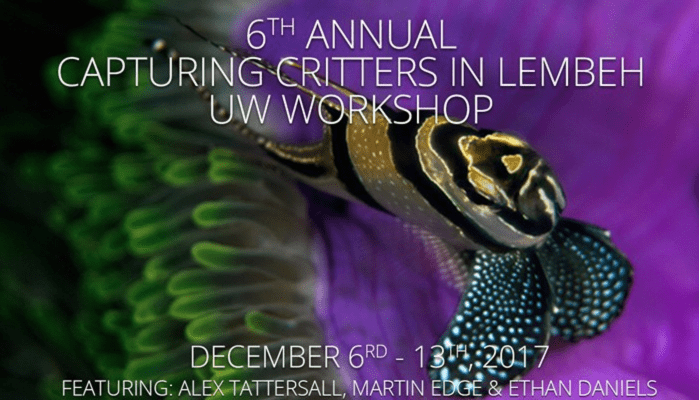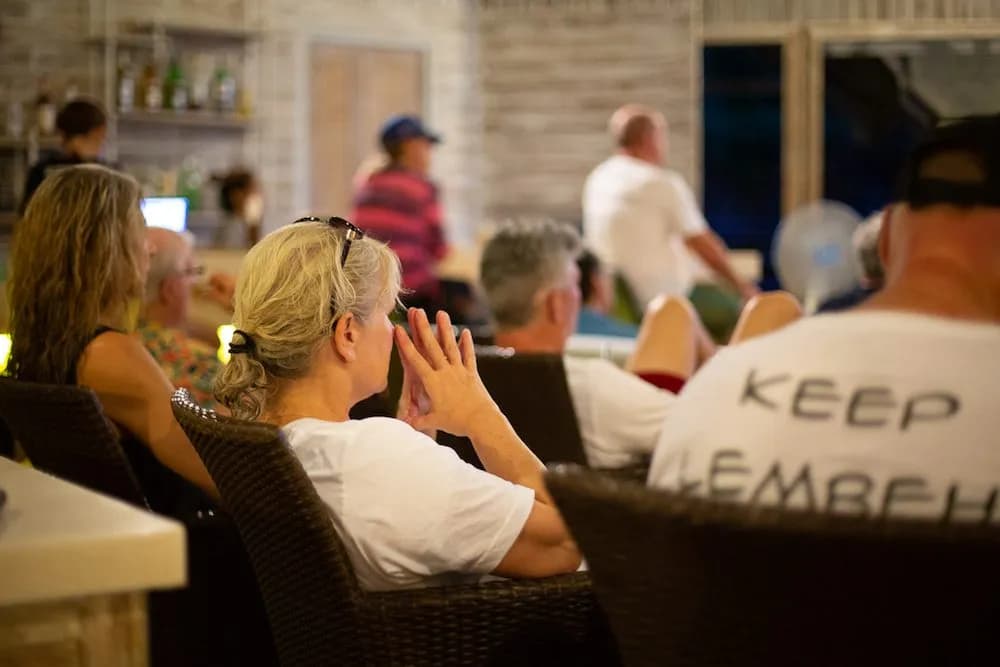Capturing Critters in Lembeh 2016 – Underwater Photography Workshop
Welcome to the Capturing Critters in Lembeh 2016 underwater photography workshop hosted here at Lembeh Resort.
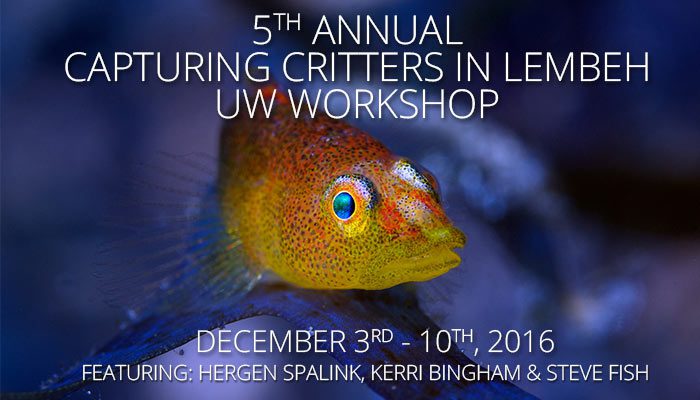
Capturing Critters in Lembeh is an annual underwater photography workshop which, over the last 5 years, has become an established and “must join” event. In our 5th year we see the return of Photo and Video Pro’s Kerri Bingham, Steve Fish and Hergen Spalink who will be heading up 7 days of underwater photography presentations, one on one sessions and underwater tuition. They’ll be tutoring participants in everything from how to set up their camera equipment and camera settings through to macro photography, lighting, super macro, composition and a whole lot more.
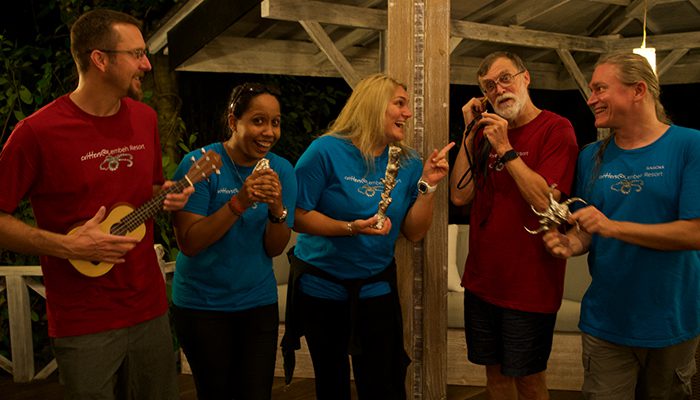
Photo and Video Pros: Hergen Spalink, Kerri Bingham & Steve Fish, in house Photo Pro Sascha Janson and in house Marine Biologist Dimpy Jacobs
Capturing Critters in Lembeh is a unique photography based experience; it’s not a competition so you’ll never feel pressured, instead you’ll always feel included and be supported. It’s a chance to have an amazing diving vacation, in one of the world’s best diving locations, with step by step tuition on all of those things that you have always wanted to know about photography but never had someone to ask. Imagine having a Photo Pro by your side on every single dive and sitting down with you individually to give you personalised tips and critiques.
This year our group of 13 participants range from complete beginners through to seasoned photographers and all of them are here to learn, improve and take advantage of the knowledge and experience of those around them. Capturing Critters in Lembeh is about personal development, camaraderie and of course, fun!
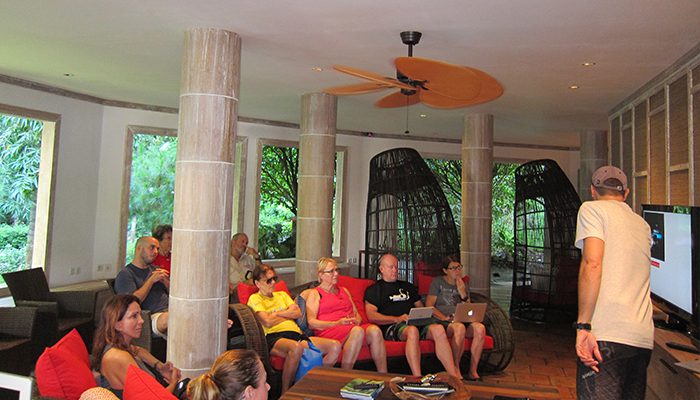
Macro concepts session by Hergen Spalink
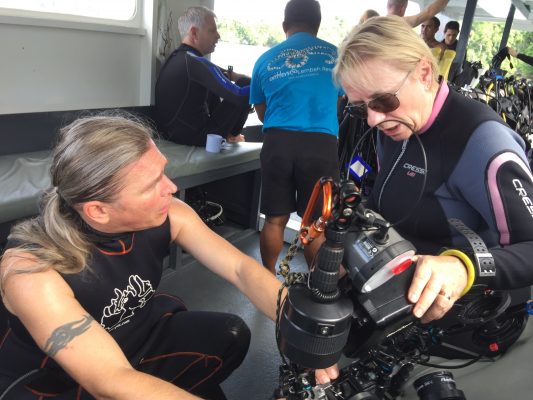
On the boat with the Pros
Lembeh Resort is located in the heart of the Lembeh Strait which is also known as the “Critter Capital of the World” due to the abundance of unusual and rare marine life found in its waters. Some of the planets most sought after species can be found here including hairy frogfish, blue ring octopus, mandarin fish, pygmy seahorses, mimic octopus, wunderpus, harlequin shrimp as well as numerous nudibranch, cephalopod and crustacean species. We believe there is no better underwater environment for honing your skills than here in the Lembeh Strait and at Lembeh Resort you’ll also experience our exceptional service which sees our guests coming back time and time again.
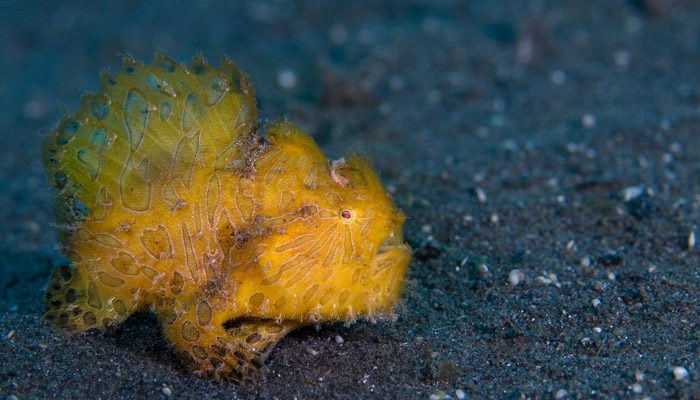
The elusive Hairy frogfish was spotted already on Day 1, stay tuned for many more amazing critters!
Yesterday was arrival day for this years participants and the event kicked off with a warm welcome and an introduction to diving here in Lembeh. Participants were briefed in “muck diving” techniques, specific guidelines for diving in Lembeh and an overview of our marine conservation practices. The 2016 underwater photography workshop promises to be our best yet and we’ll be sharing daily updates, photography tips, videography techniques and comments from our Pro’s through our website and social media platforms. Stay tuned to follow the event, get to know the Pro’s, learn some tips and techniques for yourself and join in from home!
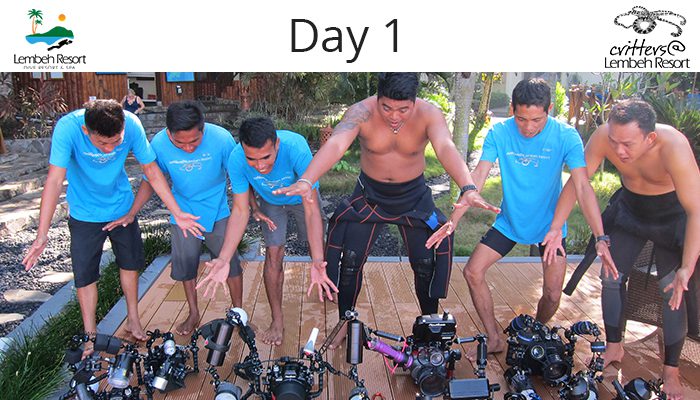
Day 1 Morning Diving Overview
This morning kicked off this year’s event with a leisurely breakfast, morning presentation and two dives. Two dedicated workshop boats set out in search of Lembeh’s finest critters, one headed up by Hergen which visited Aw Shucks and TK 1 and the other led by Kerri Bingham, going out to Critter Hunt and Hairball 1. Needless to say, we’ll be hitting up Lembeh’s premier sites throughout the week!
This morning’s critters definitely set the week off to an epic start with blue ring octopus, tiger shrimps, solar powered nudibranch and hairy frogfish! Lembeh Resort Marine Biologist Dimpy Jacobs joined the groups at TK 1 and spotted three different colorations of ribbon eel which were then photographed by participants. “It was amazing to see the divers using the techniques they had learnt in this morning’s workshop so effectively” (Dimpy).
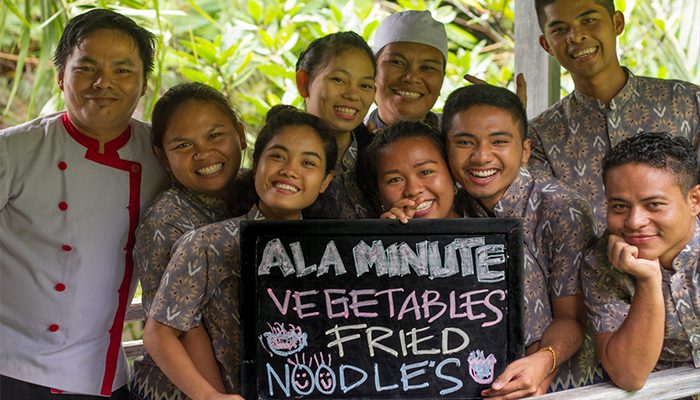
Today’s lunchtime highlight: homemade noodles!
Day 1 Afternoon Presentation Overview
Presentation: Lembeh Macro Essentials for Video Cameras by Steve Fish
During Steve Fish’s afternoon presentation he shared his knowledge and experience with us about filming macro (note: according to Steve, “experience is what you get when you don’t get what you want!)
After an overview of the basics Steve introduced this year’s videography theme – Camouflage! Every participant is now challenged with the task of finding camouflaged critters and finding creative ways of making them stand out against the background. It would be an unfair challenge without Steve giving us some top tips which included how to optimise your camera controls, when and when not to use zoom, the rule of thirds for good composition, the importance of motion and Steve’s 3 golden rules for any macro photographer and videographer:
Rule 1: Get closer
Rule 2: Get closer
Rule 3: Get closer!
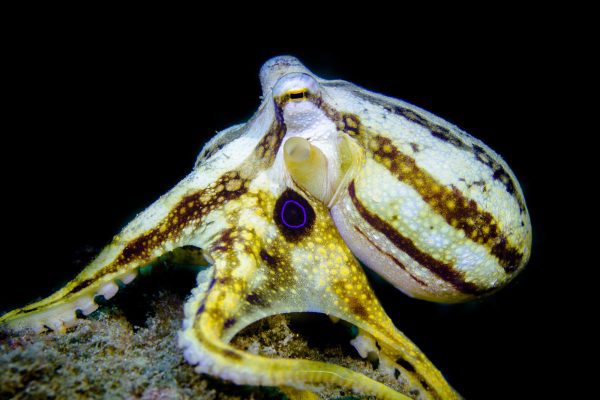
Steve’s tips proved to be worth their weight in gold as participants returned from the third dive of the day with memory cards packed with great footage. This evening they’ll be enjoying one on one time with Steve and Sascha which will include personal critiques, tips and advice before heading up to dinner and a chance to relax after a great days shooting!
Schedule of Day 1
06.45 – 07.30: Buffet breakfast with daily freshly baked bread and today’s specials of French toast, ginger soup & fried rice noodles
07.30 – 08.15: Macro Concepts Presentation by Hergen Spalink
08.30: Dives 1 & 2 with Photo Pros Kerri Bingham, Hergen Spalink and onsite Lembeh Resort Photo Pro Sascha Janson and Marine Biologist Dimpy Jacobs
12.30 – 13.30: Buffet lunch, sashimi, soup and salad bar, homemade noodles, dessert platters
13.45 – 14.15: Lembeh Macro Essentials for Video Cameras Presentation by Steve Fish
14.30: Dive 3 with Photo Pros Kerri Bingham, Steve Fish and onsite Lembeh Resort Photo Pro Sascha Janson and Marine Biologist Dimpy Jacobs
17.00 – 19.00: One on One sessions with the Pros and sunset cocktails at the pool
19.00 – 20.30: A la carte evening dinner of freshly caught swordfish, Indonesian yellow curry (Kare Kuning), Nasi Goreng Ayam and Panna Cotta
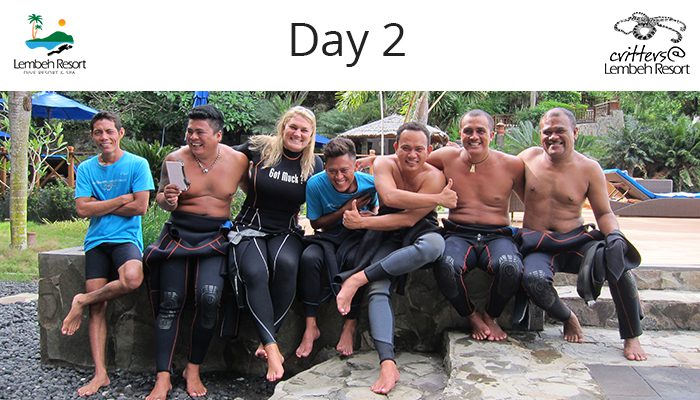
Photography Pro in the Spotlight: Kerri Bingham
Morning Day 2
It’s day 2 of the workshop and this morning we caught up with Guest Photography Pro, Kerri Bingham to get her take on Capturing Critters in Lembeh. This is Kerri’s second year as a Guest Photography Pro here in Lembeh but Kerri hasn’t always been a guest. Some of you may remember that Kerri was Dive Center Manager for critters@Lembeh Resort for three years up until 2012.
Kerri has returned to the resort numerous times since 2012, including being a Guest Photography Pro at last year’s event and she says that Lembeh is an ideal place for an underwater photography workshop. “The Lembeh Strait has easy diving conditions and an abundance of unusual critters which make it an incredible place for practicing photography skills. What sets critters@Lembeh Resort aside from other dive operations, not just in the Lembeh Strait but in Indonesia, is the level of personal service which comes from the team. The Dive Guides are all trained in photography so they understand the needs of underwater photographers. They also undergo extensive marine biology training which includes so much more than learning how to identify different critters. They all know the scientific names for each species and they learn about their habitats and behaviours which makes them incredible spotters. They are not just relying on their eyesight, they know which habitats are home to which critters and by understanding each species’ behavioural patterns they are able to point critters out to guests while ensuring minimum stress to the critter itself”.
Kerri’s main priority during workshops is to work one on one with photographers underwater to help them to develop their skills and implement what they have been learning in workshops to achieve their own personal goals. When asked what she thinks participants will take away with them from this year’s Capturing Critters in Lembeh event Kerri comments that “With all workshops we want people to take away with them what they want to take away. We are here to help people to achieve what they want to achieve and that is often something different for each participant. We aim to help people to take their photography skills to the next level and that might be through focusing on one particular aspect that they have been finding tricky, it might be helping someone to set up and understand their new system or helping people to transition from photography to shooting video. Participants are able to get out of it what they want and we facilitate them to do that.
The concept of having multiple Pro’s at the event means that participants are presented with a range of techniques and have the opportunity to try out different styles of photography. We all have different specialisations but share the same common goal of participants succeeding.
One of the reasons why Capturing Critters in Lembeh is such a successful event is due to the level of personal service and small groups underwater. You won’t find photographers “queueing up” to take a picture and there isn’t a “shoot and move on” mentality. Participants are encouraged to think carefully about every shot and they have the time to wait and observe critters in their natural environments displaying their natural behaviour and that is part of what creates a great image – allowing a critter to do its thing and waiting for the shot to unfold.”
After so many years and so many dives here in the Strait Kerri says that she is still as intrigued in the area as ever, “there is so much to see here and there is always something new, even for me. It might be a new species or witnessing a new behaviour or interaction, the Lembeh Strait never gets boring. It’s always great to see what has changed here in the resort too. Since last year’s event there’s a beautiful new restaurant, reception and lobby area which is perfect for the workshop presentations and I can’t wait to go and look at the new villa!”
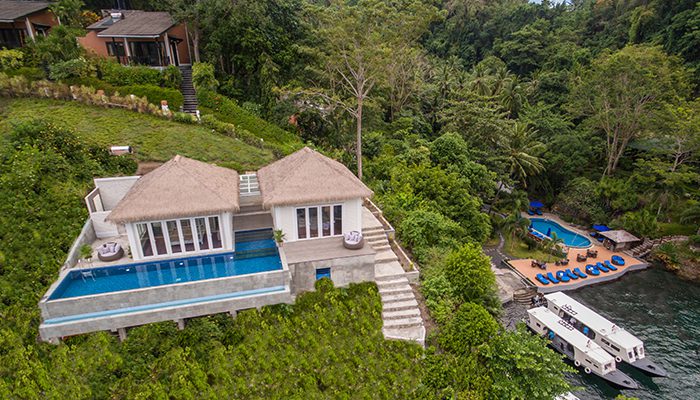
Afternoon Day 2
After a morning of exceptional critter finds which included juvenile flamboyant cuttlefish, thorny seahorses, 3 coconut octopus, bright white frogfish and pipefish it was time for the second presentation of the day, given by Hergen; “Organise or DIE!”
Hergen revealed the secrets of the great “Black Hole of Lightroom” which many photographers have been experiencing. Have you ever asked “where are my images?” or thought that Lighroom has lost your images? It was all explained and everyone was taken back to basics to learn how to catalogue and set folders within catalogues. Hergen’s quote of the day? “People lose laptops, laptops die in a nano second if your coffee cup is knocked over, laptops are sadly stolen but no-one takes an external hard drive, it will survive coffee and you always place it somewhere safe. Lightroom will allow you to save your images wherever you want them to be and you will have them forever – as long as you are organised!”
This afternoon our two dedicated boats headed out to Air Bajo and Air Prang which are two of the Lembeh Strait’s premier dive sites. With all 5 Pro’s on board we’re looking forward to seeing the images!
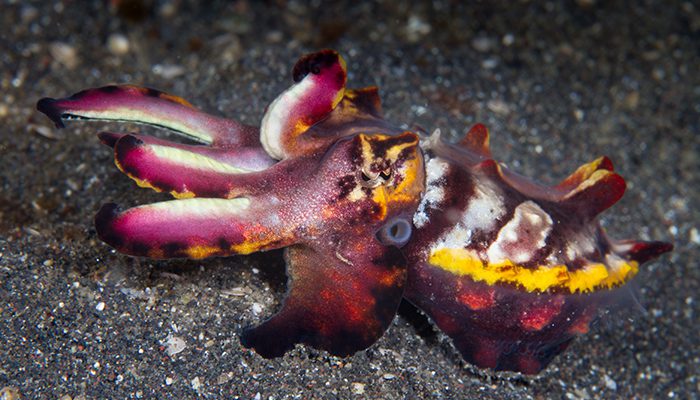
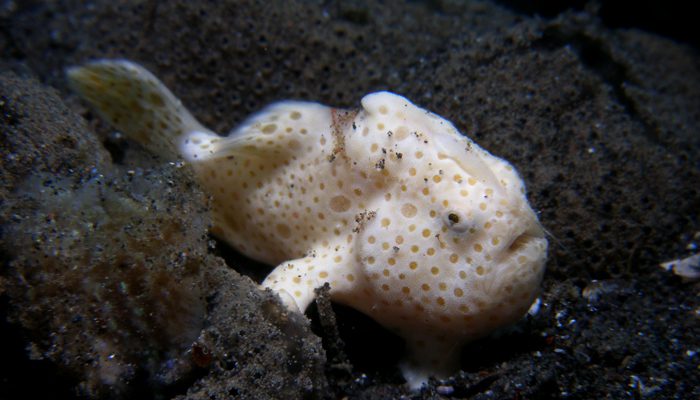
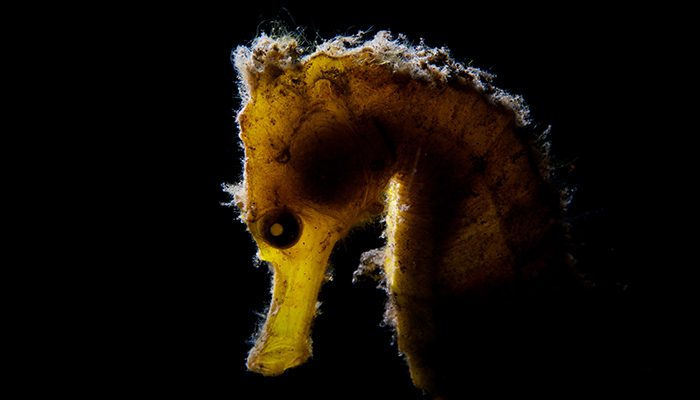
Schedule of Day 2
06.45 – 07.30: Buffet breakfast with freshly baked bread, western fare (eggs, bacon, sausages, toast, pancakes etc) and today’s specials of Soto Ayam (Traditional Indonesian chicken noodle soup), Vegetable Fritata, Indonesian Fried Rice
07.30 – 08.15: Macro Settings by Hergen Spalink. Using the best setting for macro and for your setup.
08.30: Dives 1 & 2 with Photo Pros Kerri Bingham, Hergen Spalink, Steve Fish and onsite Lembeh Resort Photo Pro Sascha Janson and Marine Biologist Dimpy Jacobs
12.30 – 13.30: Buffet lunch featuring Chinese Egg Drop Soup, Salad Bar, Mediterranean Pasta, Gourmet Mung Bean Cups, Ayam Betutu (Balinese style roasted and marinated chicken), Ikan Pindang (Asian fish with garlic, lemongrass and ginger), Vegetable Lasagne, Bola-Bola Chocolate and Banana Orange Delight.
13.45 – 14.15: “Organise or DIE!” by Hergen Spalink. An introduction to setting up your light room and storing your images.
14.30: Dive 3 with Photo Pros Kerri Bingham, Steve Fish, Hergen Spalink and onsite Lembeh Resort Photo Pro Sascha Janson and Marine Biologist Dimpy Jacobs
17.00 – 19.00: One on One sessions with the Pros or sunset cocktails at the pool!
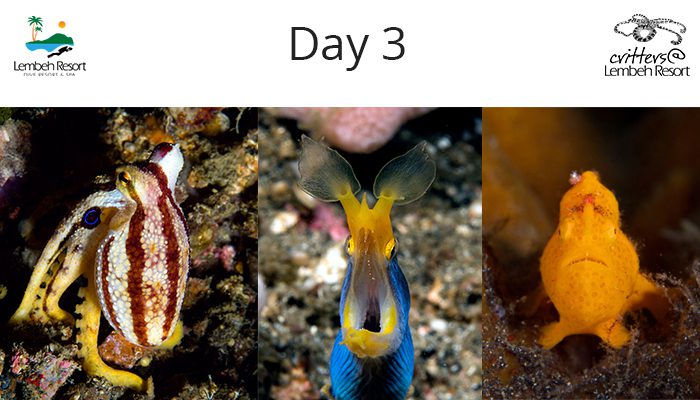
Day 3 Dive Trip Report
After this morning’s presentation with Steve Fish where this year’s participants learnt about LED lighting for both still shots and videos both boats headed out for two dives. Alucia Boat was headed up by Photography Pros Kerri Bingham and Sascha Janson along with Dive Guides Jhoe and Fandy. With 6 participants on board (Monika, Erich, Reidar, Dena, Brendan and Jessica) it was going to be a day of almost one on one time and everyone was looking forward to getting into the water to practice their new skills.
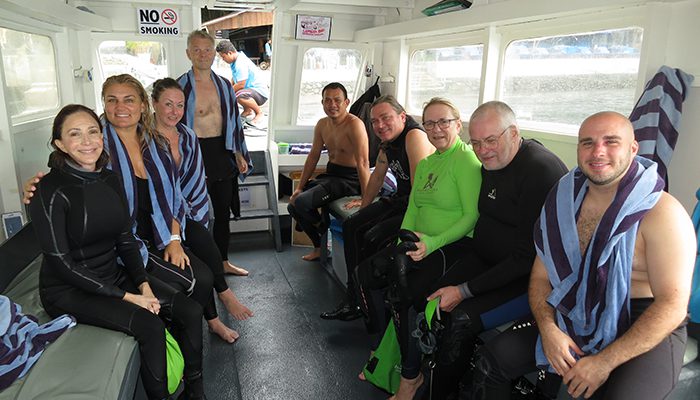
First dive of the morning was “Rojos” which is a black sand slope with scattered coral patches in the shallows. Once we had descended the sound of dive guides’ rattles started almost immediately as Jhoe spotted an emperor shrimp on the side of a sea cucumber and Kerri spotted a beautiful Janolus nudibranch. Kerri and Sascha helped the participants with their shots while the Dive Guides continued scouting for more critters. The action continued throughout the dive with a juvenile flamboyant cuttlefish at 20 meters and a white frogfish who was ready for his close-up. Heading back up the slope were two cockatoo waspfish and a soft coral crab sitting on a length of rope. With so many critters, Dive Guides and Pros nobody was waiting to take shots, queueing for critters or jostling underwater. It was a great first dive to start the day.
Back on the boat the surface interval was an “on the spot” question and answer session with Sascha and Kerri as they reviewed the shots from the first dive and gave practical advice about how the images could be improved and tips for the next dive. Following on from this morning’s lighting presentation there was a lot of talk about strobe positioning, how to use lighting to get better definition on critters that are camouflaged, how to use snoots to create different effects and shadows. Feeling refreshed with new knowledge (and surface interval snacks) it was time to hit the water again for the second dive at TK3.
TK 3 is one of Lembeh’s most famous dive sites and is a black sand slope in a large bay. The top of the reef has coral rubble patches and sea grass areas and the deeper sections also a higher density of algae and scattered anemones. TK 3 certainly did not disappoint this morning and participants had no shortage of iconic critters to shoot. Jhoe and Fandy did an amazing job of finding not one but two hairy frogfish, 2 coconut octopus, glossodoris nudibranch, numerous ceratasoma nudibranch including some with eggs and humpback scorpionfish.
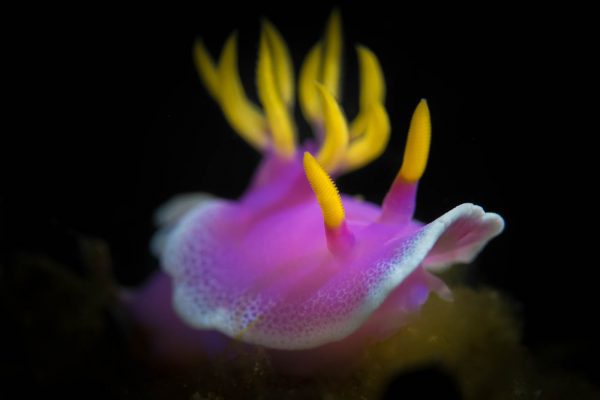
Hypseledoris apolegma
Photo by Sascha Janson
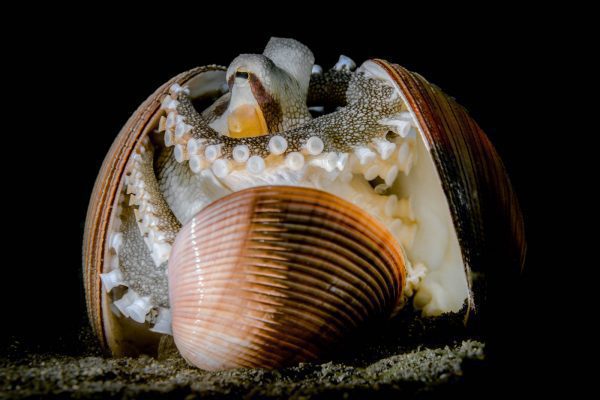
Coconut octopus playing with shell
Photo by Sascha Janson
It was 6 very happy participants that returned to resort with SD cards full of what many thought could be their best shots to date.
After lunch Hergen presented a “Live Lighting” demonstration which had everyone once again thinking about the best possible set up for their cameras and how to integrate new techniques into their systems. Images from today’s dives will be used in this evenings critique sessions with the Pros where participants will have one on one time with a Pro to review their work so far, give advice on the best way to edit their images and of course, more tips and techniques!
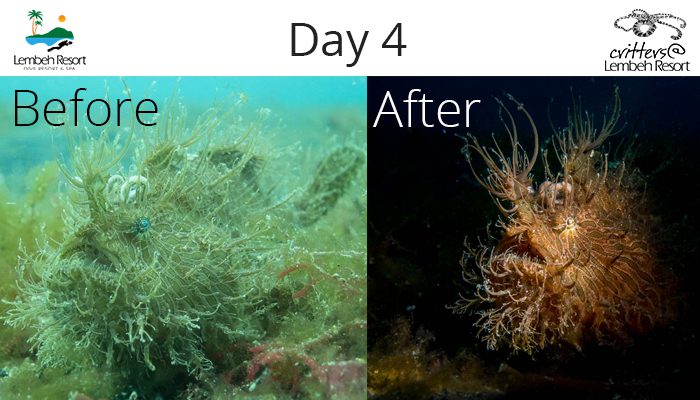
“Say No to Auto” … Manual settings made easy!
A big focus (pardon the pun) of this year’s workshop has been showing participants how to get the best possible results they can with their own individual camera systems. All participants have ventured out of “Auto” and “Program” modes have been shooting in “Manual” mode every day, which for some participants has been their first time using these settings.
The results have been quite incredible. For participants to understand how to use manual settings the presentations have taken individual settings and explained them in simple terms before moving on to more advanced techniques. The Photography Pros have included aperture, shutter speed, exposure and lighting as constant themes throughout their presentations.
New to underwater photography participant Jessica commented that, “On day 1 it seemed a lot to take in but by day 2 I was already familiar with the terms and what they meant. I was starting to understand better due to some of the great explanations given to me by the Pros. Aperture didn’t really mean anything to me but when it was likened to how your eye pupil works by becoming larger in dark conditions to let more light in it all started to make sense!”
Letting go of auto and program modes may sound daunting and this is why many photographers come to underwater photography workshops, to take the next step in improving their images. The workshops provide condensed learning, practical demonstrations and underwater practice every day for 7 days so you see dramatic improvements in a relatively short period.
The three images below were taken by Sascha during yesterdays dive to show the difference that using manual mode can really make. The first image is using standard auto mode and the frogfish blends in to the background, becoming hard to distinguish. Notice the blue green tone to the entire image and lack of vibrancy and definition.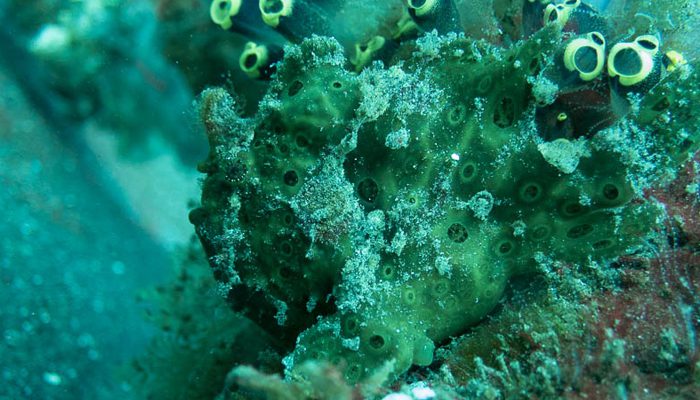
In this next image Sascha has switched to manual mode and added light. The color difference is remarkable as is the clarity. The frogfish now has definition and stands out from the background, the image is sharp and even the smallest of details are clear from the eye to the sand grains and markings on its body.
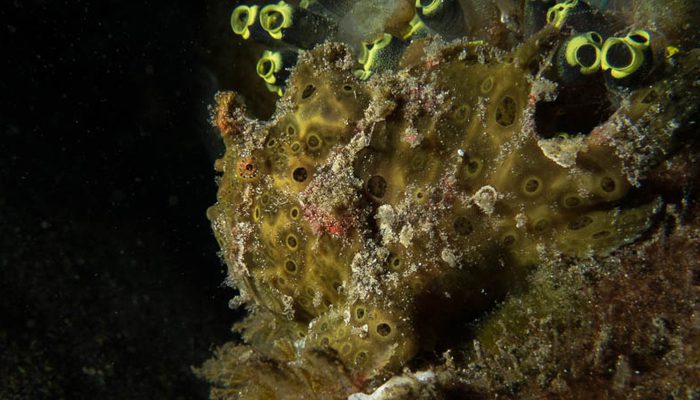
In the final image below, Sascha has added a “snoot” which is a conical or cylindrical shaped object (imagine a funnel) placed over a light to give a controlled light beam similar to a spotlight. By using this “targeted” lighting technique Sascha has managed to eliminate the background from the image and to light only the frogfish which gives the image much more impact.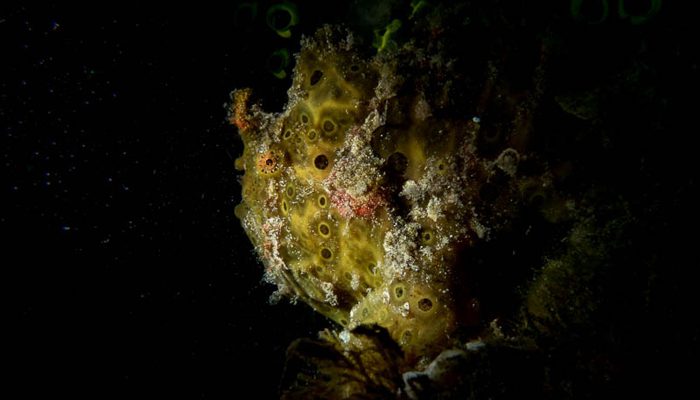
The techniques that Sascha has used above are all relatively simple (with a little bit of know-how) and are all being covered in the workshop. These improvements can be made regardless of what camera you are shooting with. What might be interesting to know is that Sascha shot all of these using a Canon s120 which is shown below. It’s a small “point and shoot” compact camera which literally fits in the palm of your hand and is only a fraction bigger than a GoPro. Sascha added a single strobe to improve the lighting (INON Z240) and a wet diopter which is similar to attaching a magnifying glass to the front of your housing (Nauticam CMC). Sascha’s snoot was made here by him in the Photo Centre!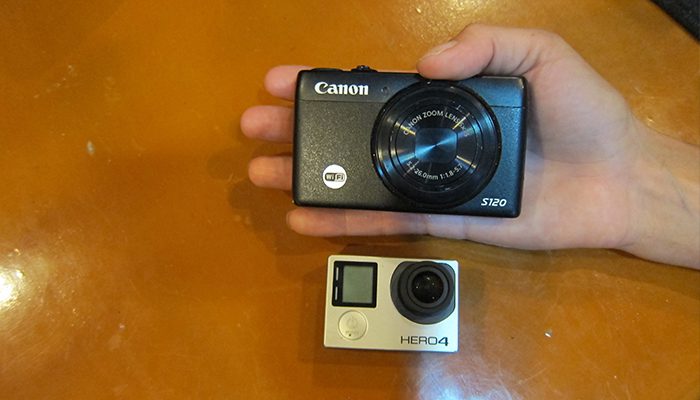
Day 4 Dive Trip Report
After Sascha’s morning presentation our two dedicated workshop boats were ready and waiting to take the participants and Pros out to their two dive sites for this mornings dives.
Andrea boat took Pros Hergen, Steve and Dimpy along with participants Monika, Erich, Reldar, Dena, Brendan, Jessica, Karen and Dive Guides Jhoe and Fandy (7 participants to 5 Pros and Guides!)
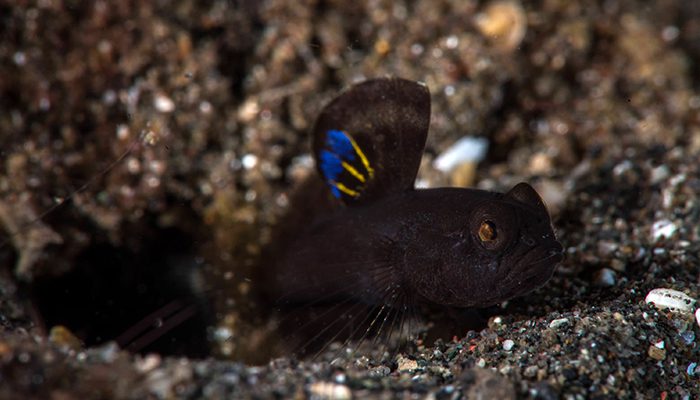
Juvenile Flagfin Shrimp Goby (Mahidolia mystacina)
Photo by Hergen Spalink
The first dive was at Binuang which is a varied site with coral patches and a stony slope which levels out to a rubble bottom at around 28 meters / 91 feet. Binuang takes its name from one of the local villages nearby.
Visibility was a little less than at yesterdays dive sites so our participants needed to adapt to the conditions. With Hergen, Steve and Dimpy “on hand” underwater and both Dive Guides in great spotting form it wasn’t long before the Dive Guides’ rattles were ringing! During the dive the participants practised their skills and new techniques on several nudibranch species including Goniobranchus kuniei, Goniobranchus sp. and Halgerda batangas. Moray eels and shrimps were in no short supply either as we found snowflake, white eye and fimbriated morays as well as clown and Sarasvati anemone shrimps. The dive rounded up with a beautiful black beareded goby.
Back on the boat the surface interval was a flurry of photograph reviewing, questions from the participants and tips and advice from the Pros. Amid the action there was still time for hot drinks and snacks all served up by the crew. With everyone feeling rested and ready for next dive we hit the water again at Sarena Besar.
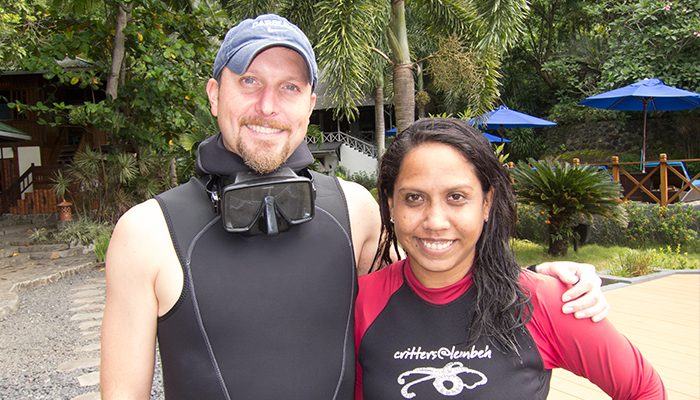
Sarena Besar is a combination dive site in front of rocky islets which offers shallow corals, deeper sandy areas and 2 main rubble patches. As if the first dive wasn’t action packed enough, Sarena Besar was teeming with critters. Among those spotted were two robust ghost pipefish, painted frogfish, egg shell shrimp, magnificent anemone shrimp, cleaner pipefish, decorator crab, box crab and a stunning Thecacera sp (Pikachu) nudibranch.
It was all smiles as the boat headed back to resort for a well-deserved lunch and rest before the afternoon actions starts!
Schedule of Day 4
06.45 – 07.30: Buffet breakfast with freshly baked bread, western fare (eggs, bacon, sausages, toast, pancakes, yoghurt, cereal etc) continental meat and cheese board and today’s specials of Tomato Soup, Nasi Kuning, Mie Goreng Sayur, Vegetable Stuffed Tofu, Fruit Platter.
07.30 – 08.15: Super Macro Photography by Sascha Janson. When “small” gets even smaller!
08.30: Dives 1 & 2 with Photo Pros Kerri Bingham, Hergen Spalink, Steve Fish and onsite Lembeh Resort Photo Pro Sascha Janson and Marine Biologist Dimpy Jacobs.
12.30 – 13.30: Buffet lunch including Soto Ayam (clear chicken noodle soup), Salad Bar and Cold Meat Station, Sesame Chicken Teriyaki, Traditional Sulawesi Fish with Mild Spices, Balsamic Roasted Vegetables, A La Minut Pasta Station. Avocado Lime Mousse, Chocolate Cheese Cake and Fruit Platter.
13.45 – 14.15: DSLR Macro Video Basics by Steve Fish. An overview of settings, lighting and getting the most out of your system.
14.30: Dive 3 with Photo Pros Steve Fish, Hergen Spalink and onsite Lembeh Resort Photo Pro Sascha Janson and Marine Biologist Dimpy Jacobs.
17.00 – 19.00: Wide Angle Presentation by Hergen Spalink. Introduction to wide angle essentials.
19.00 – 20.30: A la Carte dinner with Carrot, Ginger and Orange Peel Soup, Gado Gado, Chef’s Tuna (raw fillet of tuna with wasabi crème cheese and capers), Pan Roasted Chicken Breast, Nasi Goreng Udang (prawn and vegetable fried rice), Stufato di Maiale (slow cooked Italian pork stew), Pumpkin and Coconut Curry, Baked Meringue, Sorbet Of The Day, Fruit Platter.
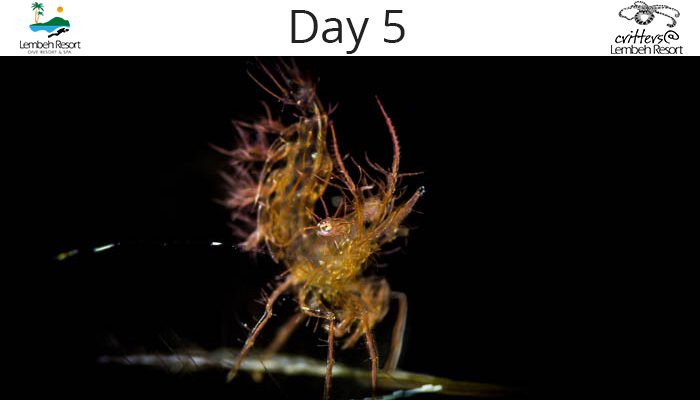
When Small Gets Smaller – SUPER Macro, Macro Lenses & Accessories
What is super macro? Super macro has various definitions according to who you ask but the simplest definition is that it means shooting REALLY small subjects. The more technical definition is that it means reproducing subjects on a scale greater than 1:1 (so the camera is “seeing” and taking a shot of a subject (critter) that appears bigger than what it is in real life).
Here in Lembeh we have no shortage of super macro critters including hairy shrimps and small frog fish but super macro can also be used to capture just a small feature of a larger critter such as the eye or the rhinophores.
Why shoot super macro? When shooting such small critters it’s extremely easy for the critter to become lost among the background but with super macro we get in very close to the critter to limit the amount of background in the shot, making the critter the star. With a regular camera lens when you move in so close the camera will lose focus and can’t find the tiny critter. Another cool factor of super macro is that because you are “increasing” the size of the critter you’ll make out features that you can’t ordinarily see with the naked eye and even when shooting in regular macro mode.
Who can shoot super macro? Almost anyone can shoot super macro regardless of whether you have a point and shoot camera or a large DSLR.
How do I prepare my camera for super macro? You’ll need to magnify what your camera is “seeing” and there are a number of ways to do this. These are the main 3 options:
1. Teleconverters
2. Dry Lenses
3. Wet Lenses
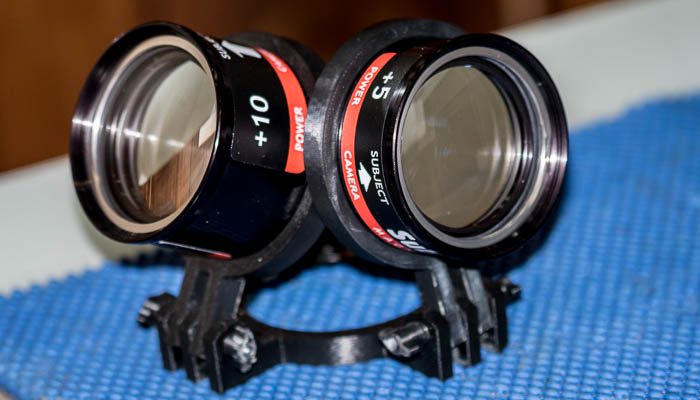
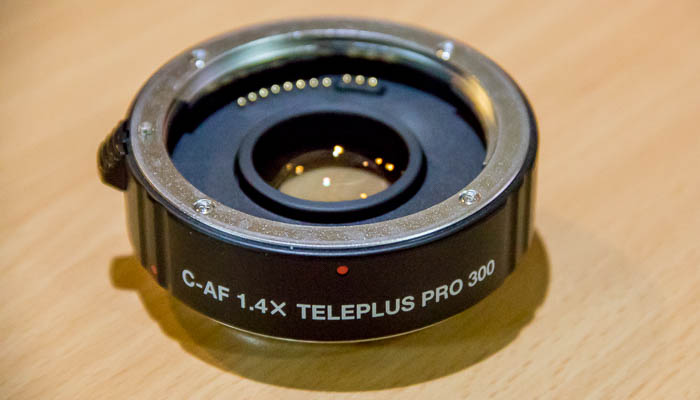
Let’s take a look at the pros and cons of each option.
Teleconverters are secondary lenses which are mounted between the camera and the lens. The advantages of using a teleconverter is that they give large scale magnification and they will focus on their entire range. This means that they will focus on a super macro critter a few centimeters in front of the lens and yet if you point into the distance they will focus on objects as far away as visibility allows! This ability to focus on small subjects from a distance is a real advantage underwater when trying to capture skittish and nervous critters which are difficult to get close to. There are down sides though to teleconverters; they are expensive, they may require the use of an extension port, they cannot be changed underwater and you will lose light so you’ll need to add more strobe light in to compensate. If you are shooting a small subject from distance it may not be possible to add the amount of light needed.
Dry lenses (macro lenses) are the cheapest solution. They are easy to add on to your camera but may still require the use of an extension port. Another advantage of dry lenses is that you won’t lose light but because they are inside your housing they also cannot be changed underwater. Unlike teleconverters dry lenses will not focus on objects in the distance – you will need to be close to the subject.
Wet lenses screw or clip on to the front of your camera housing which gives them an immediate advantage as they can be changed underwater, during your dive. Wet lenses are also a great option for point and shoot (compact) cameras. As with dry lenses they will not focus on subjects in the distance so you will need to be close to the subject but there is no light loss, if anything it is easier to light the subject as you are closer to it. Some wet lenses are attached via “flip mount” attachments which means if you want to shoot something larger from further away you can simply flip up the wet lens and revert to using your camera without it. Wet lenses are more expensive than dry lenses but are a great all round option when used correctly.
Sascha’s tip for using wet lenses:
* Get closer!
* Use the zoom function on a point and shoot and then to get focus move the camera in and out. If you don’t use the zoom function you’ll find the lens itself causes vignetting (a dark ring circling the edge of the image)
* Using a smaller aperture gives you more flexibility as you’ll increase the depth of field in focus so even if you move slightly away you still have a good chance of the image being in focus.
* If using a higher aperture there is less depth of field in focus so a slight movement of the camera (for example when pressing the shutter button) can result in capturing an area that is out of focus).
Sashca uses 3D printer technology here in Lembeh to produce custom made wet lenses with flip mounts so if you are interested in adding one to your camera system talk to him when you are in resort!
Day 5 Morning Dive Trip Report – Lembeh Strait
Dive 1
1st Dive: Nudi Retreat with Photography Pro Kerri Bingham, Marine Biologists Dimpy Jacobs, Dive Guides Jhoe and Fandy
Nudi Retreat is an iconic Lembeh Strait which features beautiful corals in the shallows and a sandy sloped scattered with boulders and two mini walls. The soft corals and gorgonian fans are a colourful highlight.
Critters: Spindle cowrie, juvenile sweetlips, hairy shrimp, broken back shrimp, glossodoris nudibranch, anemone shrimp, commensal shrimp.
Dive 2
2nd Dive: Bianca with Photography Pro Kerri Bingham, Marine Biologists Dimpy Jacobs, Dive Guides Jhoe and Fandy
Bianca is named after a large permanently moored wooden phinisi boat which is next to the site. There are branching corals in the shallows and a sand and rubble slope decorated with occasional sponges, soft corals and anemones.
Critters: 2 frogfish and a scorpion fish sitting together on the same coral head, one more painted frogfish, Banggai cardinalfish, tamja, glossodoris and nembrotha nudibranch, crocodile flathead.
Day 5 Schedule
06.45 – 07.30: Buffet breakfast with freshly baked bread, western fare (eggs, bacon, sausages, toast, pancakes, yoghurt, cereal etc) continental meat and cheese board and today’s specials of Vegetable Soup, Hash Browns and Pan Fried Tomatoes, Nasi Kuning, Nasi Goreng Sayur, Orek Tempe, Bakwan Sayur, Fresh Fruit Platter.
08.00: Day Trip to Bangka for 3 wide angle photography with Hergen Spalink, Steve Fish and Sascha Janson or two extended macro photography dives in Lembeh Strait with Kerri Bingham and Dimpy Jacobs
12.30 – 13.30: Buffet lunch including Potato Leek Soup, Salad Bar, Cold Meat Station, Sashimi, Ginger Rice, Ayam Bakar Pedas, Fish Escalope, Cap Cay, Vegetables Pizza, A La Minut Arancini, Brown Coconut Cake, Chocolate Roulade, Fruit Platter.
14.30: Macro Photography dive 3 in Lembeh Strait with Photo Pro Kerri Bingham and Marine Biologist Dimpy Jacobs.
17.00 – 19.00: Critique session with the Pros
19.00 – 20.30: A la Carte dinner with Tom Yum Goong Soup, Labu Kuning, Selada Ikan Putih Goreng, Pork in Bamboo with yellow rice, Ikan Pepes (baked fish in banana leaf with lemon grass), Pasta Pesto, Gnocchi Al Funghi, Crepes Suzzette, Sorbet, Fruit Platter.
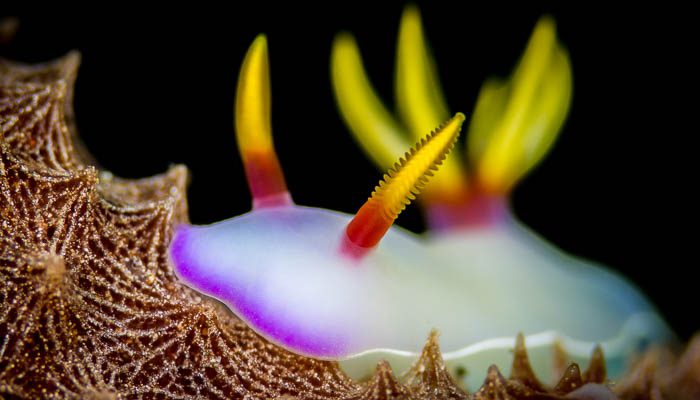
Hypselodoris bullocki
Photo by Sascha Janson
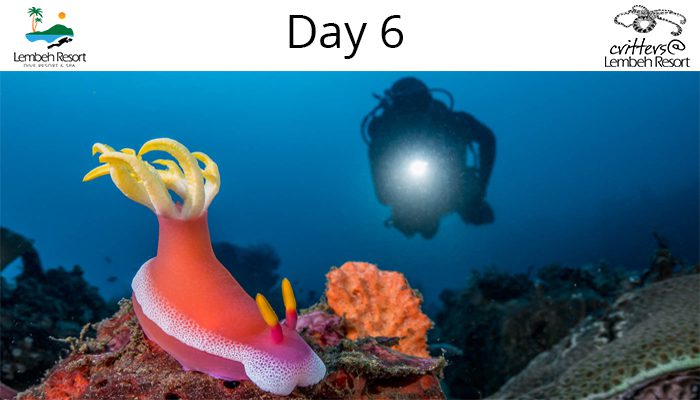
Day 6 Presentation Report
An Introduction to W I D E Angle Photography, Settings and Strobes
What is wide angle photography and how does it work? Wide angle photography means using a shorter focal distance. The shorter the focal distance, the wider the field of view from left to right (as opposed to depth of view which is from front to back). A wider field of view means that you can fit more into your frame. Here are some considerations for when shooting wide angle:
Foreground Exposure Tips
When shooting wide angle you need a clear foreground subject which is obvious to viewers. It’s important to remember that a lot of people who are looking at underwater images are not divers and so they don’t know what the “wow” factor is or what to look at. Having a clear foreground subject (such as a sponge coral with the reef behind) gives viewers a direction and helps to explain the picture to them. Once you have chosen your foreground subject it needs to be illuminated using strobes. As the strobe is turned up the foreground subject becomes more exposed but the background will not change as your strobe lights won’t travel so far underwater.
Background Exposure Tips
Just like in macro photography, your back ground is equally important and needs to be controlled to give definition to the image. Because your strobes won’t affect the background you’ll need to utilise any natural light that you have to create the best possible effect. The amount of natural light coming into a shot is controlled by shutter speed. As shutter speed increases (for example from 1/125 to 1/200 through to 1/320) the back ground will get darker. If you only adjust your shutter speed the foreground will not be affected.
Key Points to Remember
* Strobe settings will affect the foreground.
* Shutter speed will affect the background.
* Aperture will affect the exposure of foreground AND background.
What’s ISO and how does it affect wide angle images? Raising the ISO makes the camera’s image sensor more sensitive to ALL light in the scene. Raising the ISO makes it more sensitive so it will pick up more light however, it will also start to pick up “noise” which creates a grainy effect on the image.
Image Composition: Blended or Contrast
Before shooting make a conscious decision about how you want your image to look.
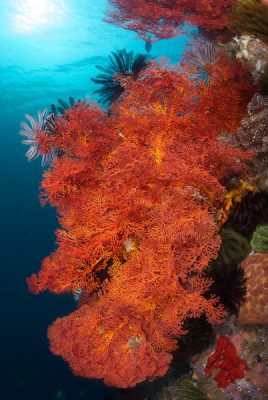
A blended image is one where the foreground subject, such as the fan above, is illuminated by strobe light and the back ground is lit by natural light (in the above image the back ground is the bright blue water and the sun) so the front and back of the shot blend together to create one image (with emphasis on the foreground subject). Blended images also work well with shallow reef top scenes.
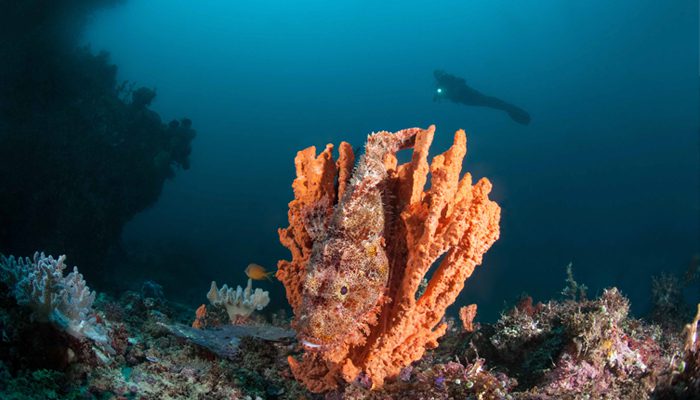
A contrast wide angle shot is one where the foreground is again illuminated by the strobes – in the image above the scorpion fish on the orange sponge. Next look at how the background is not lit at all, notice how the reef wall on the left of the image and the diver are just dark silhouettes with no colour or detail and the water column is a very dark blue. A contrast image works very well when there is an unattractive background such as a rubble reef top which you don’t want to draw attention to. Contrast is also a good choice when shooting neutral or light coloured foreground subjects as they will really stand out against a darker back drop.
Strobe Positioning
Remember that you want your strobe beams to meet on the foreground subject. If your strobe beams meet behind it you are too close and your foreground subject won’t be illuminated or will be illuminated on the left and right but not in the middle. If your strobe beams meet in front of the subject you are too far away and because you are shooting more water you’re more likely to get backscatter. As a general rule the distance from the camera to the subject should be equal to the distance from the camera to the strobes, so if you move away from the subject extend your strobes out to the sides and if you move closer to the subject move your strobes back in.
Final tip from the Pros: In “nature” light always comes from above (the sun) and this casts natural shadows. For this reason your strobes should be positioned slightly above your camera. If you shoot with them at the same level as the subject your image won’t have any shadows which appears unnatural. If you are shooting with a single strobe the ideal position is above the camera in a centralised position. Single strobes can also be used at 45 degree angles to the subject to create interesting light and shadow effects.
Day 6 Morning Dive Trip Report – Bangka Island Wide Angle Trip
With Photography Pros Steve Fish, Hergen Spalink and In House Photo Pro Sascha Janson and In House Marine Biologist Dimpy Jacobs. Dive Guides Abner and Nolfi.
For today’s trip we chose to make both dives at Sahoung which is an iconic Bangka dive site famous for its kaleidoscopic soft corals. It’s a great site for wide angle photography as it has interesting topography including a wall with gorgonian fans and soft corals, a pinnacle which rises up in a unique step like formation, a slope, bright anemones, varied corals and it’s a hotspot for schooling fish.
Unlike on other days during the workshop our Dive Guides today were not searching for critters, they were honed in on pointing out suitable wide angle subjects for our participants to put into use the skills they learnt in the wide angle workshop with Hergen Spalink.
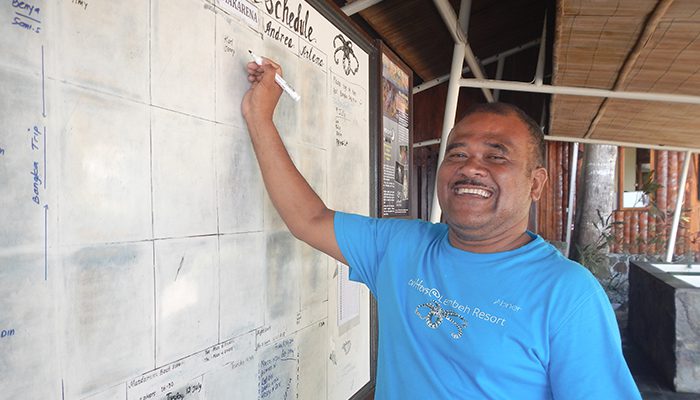
Dive Guide Abner gave us an overview of the trip:
“This morning we went up to Bangka to dive at Sahoung which takes around 1 hour 10 minutes from Lembeh Resort. The sun was shining this morning and the sea was flat and calm. We decided to make two dives in the same spot so the photographers have the chance to go back to subjects they
want to try and shoot again on the second dive. The first dive had no current and good visibility which was perfect for wide angle. Most of the participants were focused on taking shots of the fans and soft corals because they are so colourful and make really nice images. One of the participants was shooting the anemones and another was practicing on coral bommies – I think they both got nice shots. On the second dive there was a large school of 5 line yellow snapper which was really great for wide angle. The sponges at Sahoung are also really good wide angle subjects against the blue. At the end of the dive Sahoung has a pinnacle which looks like a staircase and that was a highlight too as you can shoot up and on sunny days the sun rays filter down through the water. We went to Murex Bangka for lunch and then headed back in the afternoon”.
Of course, Abner wouldn’t be Abner if he didn’t see some critters too and whilst looking for larger subjects he also spotted bargibanti pygmy seahorses and numerous nudibranchs including ceratasoma and chromodoris. Way to go Abner!
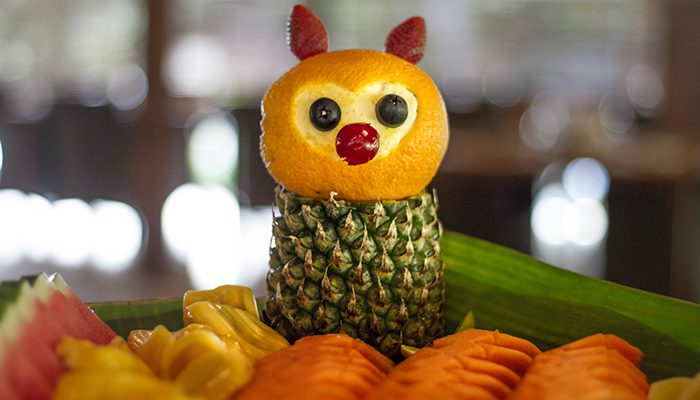
Day 6 Daily Schedule
06.45 – 07.30: Buffet breakfast with freshly baked bread, western fare (eggs, bacon, sausages, toast, pancakes, yoghurt, cereal etc) continental meat and cheese board and today’s specials of Soto Ayam (clear chicken noodle soup), Mushroom and Vegetable Quiche, Nasi Kuning, Mie Goreng Sayur, Tahu Isi Sayur, Fruit Platter.
07.30 – 08.15: Basic Lightroom Editing by Hergen Spalink. An introduction to processing your images to achieve the best results.
08.30: Dives 1 & 2 with Photo Pros Kerri Bingham, Hergen Spalink, Steve Fish and onsite Lembeh Resort Photo Pro Sascha Janson and Marine Biologist Dimpy Jacobs.
12.30 – 13.30: Buffet lunch including, Roasted Tomato Soup, Salad Bar and Cold Meat Station, Potato au Gratine, Pork Stew with local herbs, Bihun Goreng, Sayur Acar, A La Minut Tuna Fillet, Corn and Eggplant Salad, Coffee Mousse, Sweet Potato Cake and Fresh Fruit Platter.
13.45 – 14.15: Negative Space by Hergen Spalink. Why what’s around your subject is so important.
14.30: Dive 3 with Photo Pros Steve Fish, Hergen Spalink and onsite Lembeh Resort Photo Pro Sascha Janson and Marine Biologist Dimpy Jacobs.
17.00 – 19.00: Office Hours, one on one sessions with the Pros
19.00 – 20.30: Traditional Indonesian buffet night with an assortment of classic Indonesian dishes from North Sulawesi and around the Archipelago.
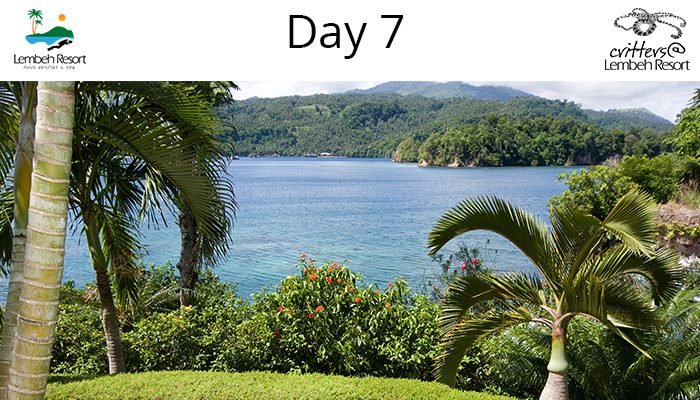
Day 7 Wrap Up Report
Last night was the final evening of our 5th annual Capturing Critters in Lembeh underwater photography and videography workshop and we rounded off the week in Lembeh Resort style.
The evening kicked off with an event round up from our Pros (Kerri Bingham, Hergen Spalink, Steve Fish, in house Photo Pro Sascha Janson and in house Marine Biologist Dimpy Jacobs) who celebrated the successes of all participants by showing a stunning slide show of the best images that have been created during the week. The images have exceeded all of our expectations as we have seen some participants go from complete beginners to competent shooters with a newly found understanding of photography concepts and of their individual systems and we’ve seen already seasoned photographers shooting with DSLR’s produce some of their best ever shots by developing their existing techniques and learning some new skills to complement them.
This morning we will wave goodbye to 4 of our participants while the other 8 will stay on for the three day advanced extension to keep fine tuning their skills and learning more in depth techniques.
Kerri Bingham mentioned on the first day of the workshop that their (the Pros) aim was to make sure that every participant got out of the workshop what they came here for and we think we can safely say “mission accomplished”.
Participant Mignon Pilling commented that “I really enjoyed the workshop. I learnt a lot of tips and ideas and now I want to invest in a new light so I can increase my depth of field. I really learnt so much. This is my second time in Lembeh and I plan to return when I have my new equipment as this is the best place to come for help and learning”.
Following the slide show (and some speeches and lots of thanks) it was time to kick back and enjoy the evenings Indonesian Buffet Banquet which included a range of classic Indonesian dishes from both North Sulawesi and from across the Archipelago. The incredible team of Chef’s produced numerous mouth-watering dishes including satays, sumptuous ayam bulu (chicken cooked in bamboo), gado gado, martabak, beautiful vegetable fritters and of course all served with traditional side dishes, vegetables, sambals and condiments followed by a selection of delectable sweets, pastries, cakes and desserts.
As dinner was drawing to a close the children from the local Sunday School choir came along to join the party and gave singing and dancing performances which included traditional church songs. Two members of Lembeh Resort staff, Helen (Restaurant Captain) and Narsi (Waitress), are volunteers at the local Sunday School. Some of the children from the choir are also beneficiaries of our donation program which focuses on providing support for children from the most disadvantaged families in our two local villages of Pintu Kota Besar and Pintu Kota Kecil.
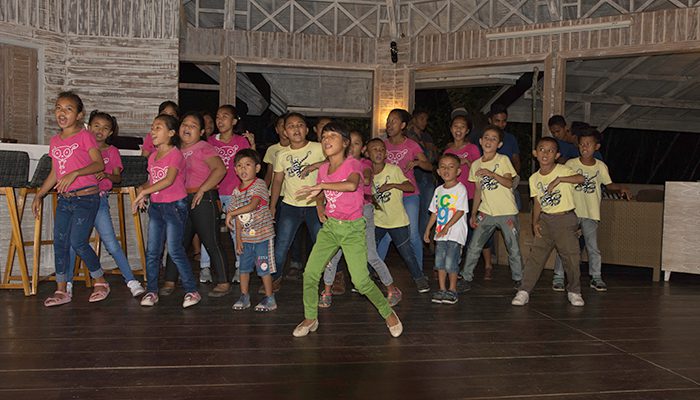
Each year we carry out surveys among the villagers from both communities to identify those most in need. The donation monies we have collected are then used to buy backpacks, uniforms and school materials to be given to the children so that they can continue their education. We have also funded a computer station in each of the two villages where the children can go to learn computer skills as the schools do not have IT facilities.
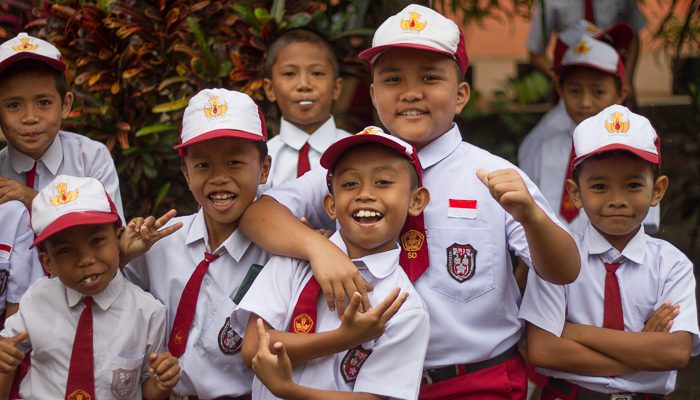
This year, as part of Lembeh Resorts ongoing social and environmental commitment, Managers Morten Lund and Petra Schmiedl are spearheading a new campaign aimed at motivating and educating local children about the wildlife of North Sulawesi and the importance of conservation. Lembeh Resort has supplied two local schools with paper, pencils and crayons and challenged the children (aged 6 – 12 years old) to a drawing competition. The drawings can be of any wildlife found in North Sulawesi (not necessarily marine life) and the winning images will be chosen by guests at Lembeh Resort who will vote on December 24th. The children whose images are selected will win a day trip to the Tasik Oki Wildlife Rescue Center where they will learn about protecting the regions incredible wildlife and they will get to see some of the animals being rehabilitated there which often includes orangutans, sun bears, black macaques, slow loris, babi rusa and a various species of birds. Tasik Oki is also a popular day trip for guests here at Lembeh Resort and can be combined with a visit to Tangkoko National Park to see many of these species in their natural habitat.
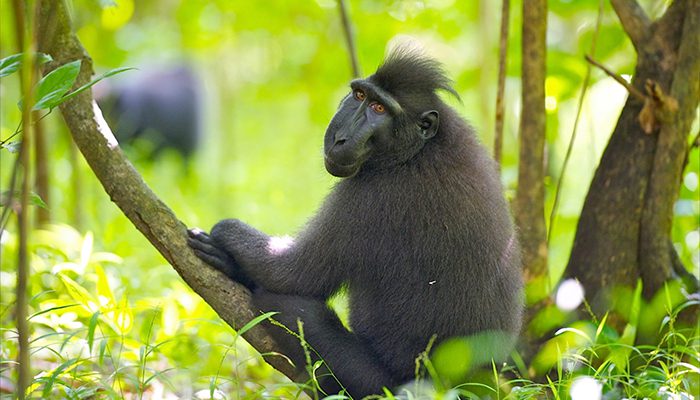
Schedule of Day 7
06.45 – 07.30: Buffet breakfast with freshly baked bread, western fare (eggs, bacon, sausages, toast, pancakes, yoghurt, cereal etc) continental meat and cheese board and today’s specials of Ginger Vegetable Soup, Nasi Kuning, Mie Goreng Sayur, Bakwan Jagung, Telur Sambal and Fresh Fruit Platter.
08.00: Day Trip to Bangka for 3 wide angle photography with Hergen Spalink or two extended macro photography dives in Lembeh Strait with Kerri Bingham and Dimpy Jacobs
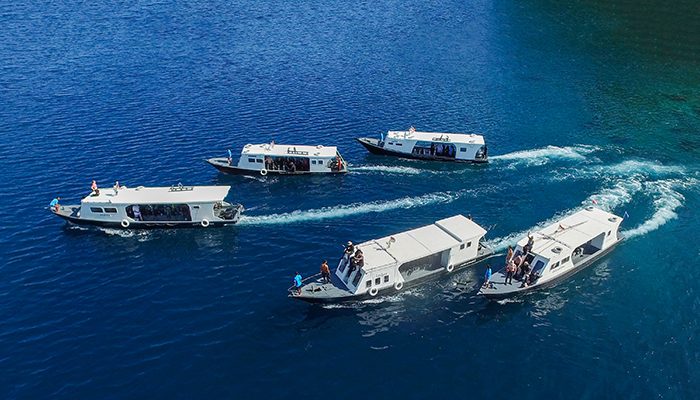
12.30 – 13.30: Buffet lunch including Mushroom and Herb Soup, Salad Bar, Cold Meat Station, Shrimp Cocktail, Nasi Kuning, Grilled Corn, Beef Rendang, Assorted Seafood Fritters, Aglio Olio Pasta, Sauteed Vegetables, Home Made Espresso and Kenari Nougatine Ice Cream, Fruit Platter.
13.45 – 14.15: Marine Life Presentation – Flamboyant Cuttlefish with in house Marine Biologist Dimpy Jacobs
14.30: Macro Photography dive 3 in Lembeh Strait with Photo Pro Kerri Bingham and Marine Biologist Dimpy Jacobs.
17.00: Focus Stacking Presentation by Steve Fish – Steve’s latest developments shared with participants.
19.00 – 20.30: A la Carte dinner with Gazpacho, Avocado and Young Papaya Salad, Balinese Marlin Salad, Oven Roasted Pork Ribs, Snapper Fillet with Lime Butter Sauce, Mie Goreng Ayam, Baingan Bhartha (Chargrilled eggplant with curry spices, rice and naan bread), Chocolate Pot De Cream, Sorbet, Fresh Fruit Platter.
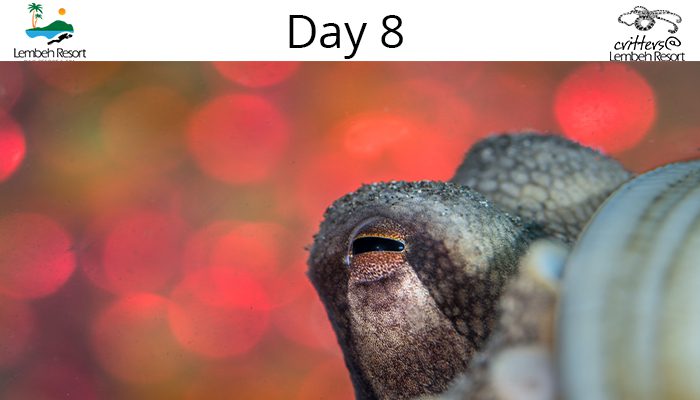
Day 8 Presentation Report
Creative Photography Effects
Background: What is “negative space?” Negative space is anything that is in a picture that is not the primary subject. When shooting macro we focus on trying to eliminate the background so that the subject “pops” but before eliminating it always consider if it actually adds something to the image. Critters that are perched on other critters are a prime example, such as a harlequin shrimp on a blue sea star which also adds to the story behind the image. Another example would be an emperor shrimp on a nudibranch or sea cucumber.
The background doesn’t need to be another critter. Consider the patterns, texture and color of the coral the critter is sitting on and ask yourself if it actually complements and enhances the image before deciding to eliminate it.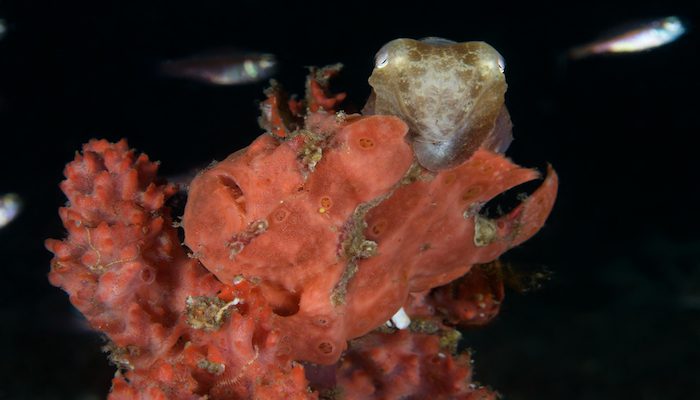
Painted Frogfish ( Antennarius pictus ) and Broad-club Cuttlefish ( Sepia latimanus )
Photo by Kerri Bingham
The black background: There is no doubt about it, when you have an uninteresting or distracting background then the black background option really makes an image stand out. To achieve a black background you will need to increase you aperture and shutter speeds to reduce the amount of light coming in to the shot and the depth of field.
Creative lighting? Creative lighting basically means using your lights and strobes to enhance the image. This can be by softening it by turning down your strobe or using a snoot to give a targeted light beam.
Snoots: Snoots are cylindrical shaped (like a funnel) and are placed over your strobe so that it projects only a narrow beam. When creating a snoot image try out different options such as holding the snoot directly above the subject which creates interesting shadows, positioning the snoot at an angle and down low or illuminating the critter head on and shooting from side on. A snoot is also a great way to back light images (see below).
LED Lights: LED lights can be used as an alternative to snoots providing they have a “spot” setting. The spot setting emits a narrow beam, like a spot light, rather than illuminating the entire area as they do on the “flood” setting. The advantage of using LED lights over snoots is that you can position them and then see the effect before you shoot as you have continuous light on the subject unlike with a snoot and strobe which only flashes when you shoot.
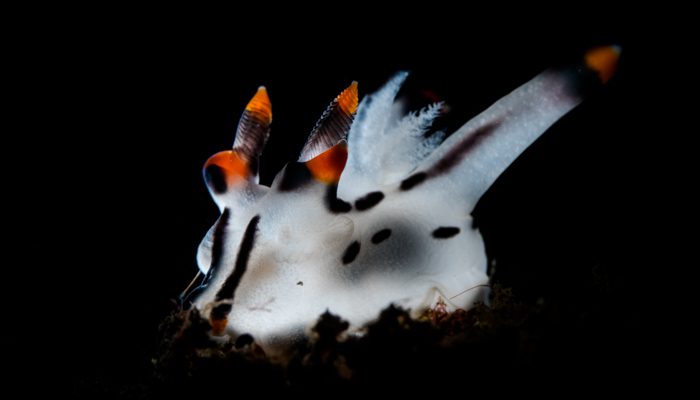
(Thecacera picta)
Photo by Sascha Janson
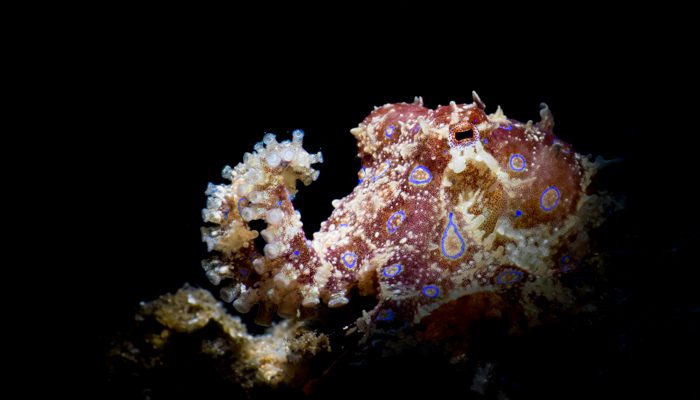
Blue-ring Octopus ( Hapalochlaena spp.)
Photo by Sascha Janson
Laser Snoots: These have a laser beam which is continuous and so allows you to line up your strobe prior to taking an image but they should not be directed at the eyes and that is usually what we are trying to get into focus. For that reason laser snoots are not recommended unless used extremely carefully and with sensitivity to the creature. An LED light is a much better and safer option.
Flip Mount Snoots: As the name suggests these clip on to your strobe and can be flipped up at any time when you want to use regular strobe light. Sascha actually makes flip mount snoots here in resort.
Backlighting: Backlighting is extremely effective when shooting translucent or hairy critters. It helps if you have another diver with you who can position themselves with the light or snoot behind the critter. Next move yourself in to place so that the light, the critter and your camera are all aligned.
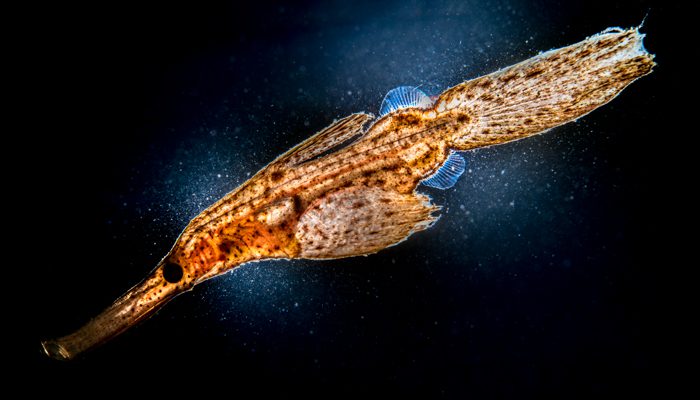
Robust Ghostpipefish ( Solenostomus cyanopterus )
Photo by Sascha Janson
Pro Tip of the Day: When experimenting with creative lighting find an object which is roughly the same size as the critter you want to shoot and take test shots until your camera is in focus and your strobes / lights are set in the correct position. Once you have your settings perfected move on to the critter and position yourself the same distance away (best guess) and then move your camera in and out until it focuses and the strobes should already be in the correct place. This saves taking numerous “test” shots on the critter.
Day 8 Morning Dive Trip Report
With Photography Pros Hergen Spalink, Kerri Bingham, Steve Fish and in house Photo Pro Sascha Janson and in house Marine Biologist Dimpy Jacobs and Dive Guides Agus and Ramli.
Dive #1: For the first dive we chose Makawede which is named after a nearby village. The site has vibrant coral growth in the shallows, a rubble and sand slope and a pair of pinnacles. This is a great site for spotting a variety of nudibranch as we proved this morning!
Critters: Thorny seahorse, broadclub cuttlefish, juvenile banded pipefish. Nudibranch: Nembrotha chamberlain, Thecacera Sp. and Hypselodoris bullocki
Dive #2: Pantai Parigi – one of our favorites! A white sand muck site with healthy and dense coral growth in the shallows then a gentle white sand slope which is a good place for finding snake eels and octopus. We didn’t spot any octopus this morning but we did see a Napoleon (clown) snake eel out swimming.
Critters: Pontohi pygmy seahorse, Ambon scorpionfish, Napoleon snake eel, orangutan crab and xenia filefish.
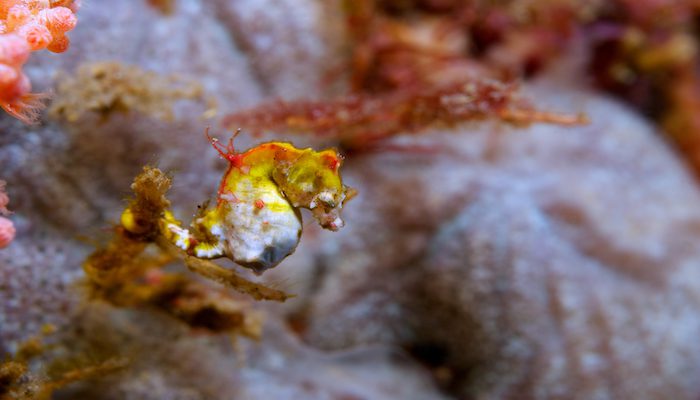
Pontohi Pygmy Seahorse ( Hypocampus pontohi)
Photo by Hergen Spalink
Schedule of Day 8
06.45 – 07.30: Buffet breakfast with freshly baked bread, western fare (eggs, bacon, sausages, toast, pancakes, yoghurt, cereal etc) continental meat and cheese board and today’s specials of Tomato Soup, Nasi Kuning, Nasi Goreng Sayur, Mushroom and Vegetable Quiche, Tempe Tendoan, Fresh Fruit Platter.
07.30 – 08.15: Advanced Lightroom by Hergen Spalink. Taking a look at advanced techniques for enhancing images and creating artistic effects.
08.30: Dives 1 & 2 with Photo Pros Kerri Bingham, Hergen Spalink, Steve Fish and onsite Lembeh Resort Photo Pro Sascha Janson and Marine Biologist Dimpy Jacobs
12.30 – 13.30: Buffet lunch including Soto Betawi (clear chicken, vegetable and coconut soup), Salad Bar and Cold Meat Station, Braised Chicken with Indonesian spices, honey and chili), Traditional Sulawesi Fish with Mild Spices, Vegetable Puff Pie, Cah Kangkung, A La Minut Pasta Station. Pumpkin Pie, Cannoli and Fresh Fruit Platter.

13.45 – 14.15: Video Editing Work Flow (Part 1) by Steve Fish. Organising your work flow to simplify editing and achieve the best results.
14.30: Dive 3 with Photo Pros Steve Fish, Hergen Spalink and onsite Lembeh Resort Photo Pro Sascha Janson and Marine Biologist Dimpy Jacobs
17.00 – 19.00: Critique Session with the Pros. Advice, feedback, tips and techniques from the Pros.
19.00 – 20.30: A la Carte dinner with Soto Ayam, Homemade Spring Rolls, Spinach Tempura Salad, Sautéed Squid, Slow Roasted Duck Leg, Mahi Mahi Baked in Bamboo, Riz au Lait, Sorbet of the Day, Fresh Fruits
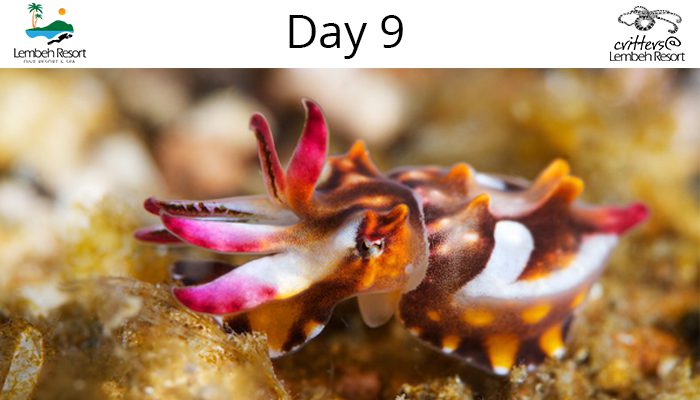
Day 9 Marine Life Presentation Report
Flamboyant Cuttlefish
The flamboyant cuttlefish (Metasepia pfeffferi) is one of the most iconic critters of the Lembeh Strait and one that everyone wants to take a picture of. But how much do you know about this tiny critter? In this post critters@Lembeh Resort in house Marine Biologist Dimpy Jacobs reveals all!
The flamboyant cuttlefish is not only found in Indonesia, sightings have also been reported in Malaysia, Papua New Guinea, Philippines and also in Northern Australia. They are found on sand, muck and rubble bottom compositions at depths of over 3 meters.
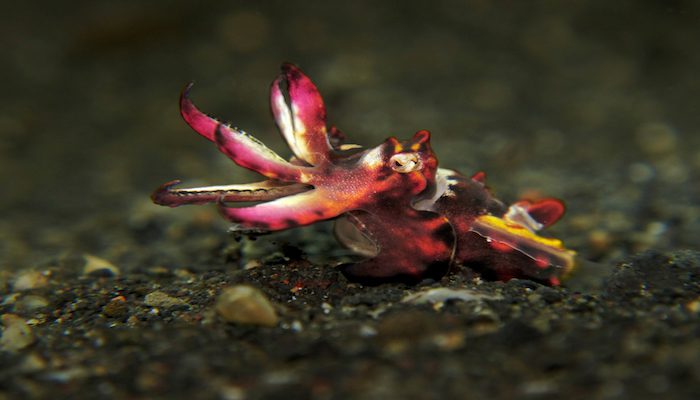
Flamboyant Cuttlefish (Metasepia pfefferi)
Photo by David Allen
When they are not flashing their bright colors they can change their color and skin textures to match that of the bottom composition which makes them very difficult to spot by predators… and by divers. When they are flashing they are anything but camouflaged and can be spotted from some distance away despite being only small. Females will grow up to 10cm unlike their male counterparts which will only reach around 6cm.
Flamboyant cuttlefish are equipped with eight forward reaching arms, in the middle of which is a small “beak” which they use to break open the shells of molluscs, crabs and other crustaceans. In addition to eight arms, cuttlefish also have two longer tentacles, whose ends are called tentacle clubs. Tentacle clubs have flat surfaces with several enlarged suckers located in the center of the clubs. They use these two elongated tentacles to grab their prey and the two work together.
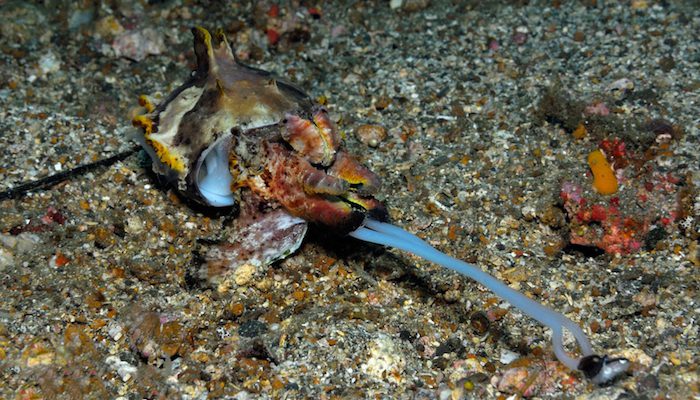
Flamboyant cuttlefish catching its prey
Photo by Barbara Moll
Did you know that cephalopods have 3 hearts? It’s true! The flamboyant cuttlefish uses two hearts to pump blood to the gills and one to circulate oxygenated blood around the body. Despite having multiple hearts the flamboyant cuttlefish has a lifespan of around only one year.
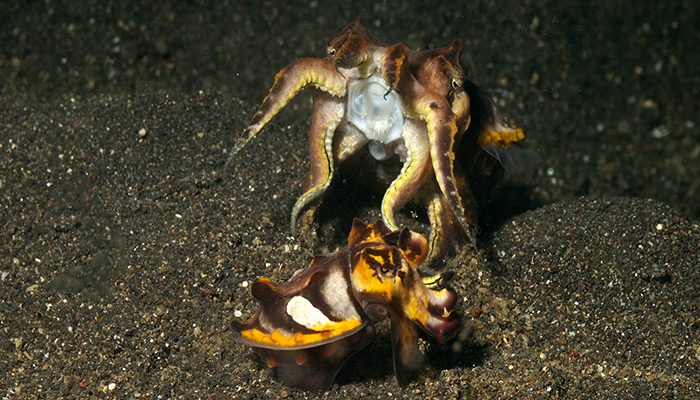
Pair of Flamboyant Cuttlefish get ready for mating
Photo by Claudia Rusch
One of the most interesting behaviors we see here in Lembeh is the flamboyant mating, which occurs in a head to head position. One of the males arms is a “hectocotylus” which is used for holding and transferring sperm into female’s buccal cavity. Mating takes place rapidly, a few seconds at most, and can occur several times with the same partners. Like most cephalopods, they are polyandrous (female may mate with more than one male) which studies have shown results in more offspring and larger, healthier offspring!
When she is ready the female will then find a place to lay her eggs, which she does one by one. They prefer to hide the eggs under coral, shells, rocks or on the underside of empty coconut halves. It takes a few minutes for her to produce and lay each egg which is about 1cm in diameter. The eggs are initially white and round and become more transparent as they develop. The incubation period is around 3 – 4 weeks. Newborns are about 1 cm long and are immediately able to walk, hunt, squirt ink, etc. They grow quickly and reach adult size in just 4 months.
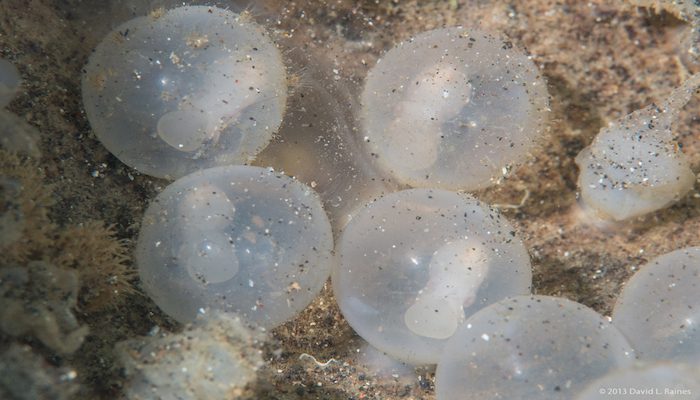
Newly laid flamboyant eggs
Photo by David Raines
Why do they have ink? Flamboyant cuttlefish use ink as their defense mechanism. They can shoot a small but thick cloud to confuse predators. Their main predators are unknown but hermit crabs and sea snails have been seen eating their eggs. It is not yet known if the flamboyant is poisonous or toxic.
Flamboyants are unique compared to other cuttlefish in the way that they move. They walk along the bottom using tentacles and specially adapted flaps on the bottom of their mantles instead of swimming. This is because they have a smaller than normal cuttlebone. All cuttlefish have a cuttlebone made of calcium carbonate. The cuttlebone has several chambers which the cuttlefish can empty or fill with gas in order to adjust its buoyancy. Because the flamboyant has a small cuttlebone, they find it more difficult to adjust their buoyancy and cannot swim long distances.
Today’s Pro Tip from Dimpy: These colorful critters are well worth watching passively, once relaxed in your presence they quite often display interesting and unique behavioral traits. Take your time and don’t pressure the cuttlefish and you might be surprised by what it does!
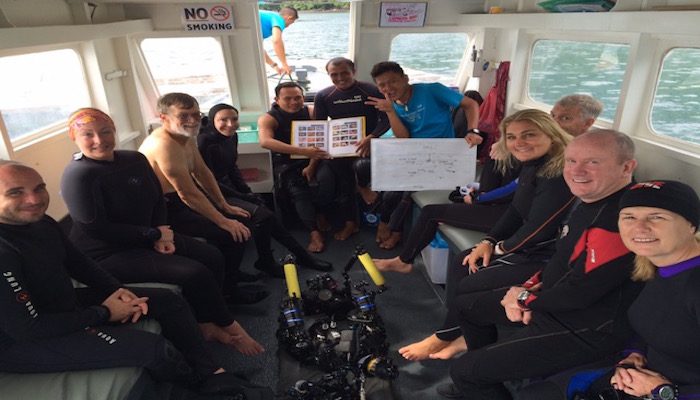
Day 9 Morning Dive Trip Report
With Photography Pros Hergen Spalink, Kerri Bingham and Steve Fish.
For the first dive today we headed out to Jahir 1 in search of stargazers and we were not disappointed! Participants took some great shots of the distinctive teeth and eyes protruding from the sand. Visibility was good today with flat and calm conditions and among other critters we also spotted a fireworm, cockatoo waspfish and cryptic sponge shrimp.
After a relaxing surface interval, which included light refreshments, a lot of picture reviewing and tips from the Pros, we hit the water again at Makawide which is a combination site of shallow coral and a sand and rubble slope. The site also features two pinnacles which provided participants with numerous nudibranch sightings and today we found not just 1 but 3 species of pygmy seahorses! Once again all participants headed back to Lembeh Resort excited to review and edit their images, and of course lunch!
Schedule of Day 9
06.45 – 07.30: Buffet breakfast with freshly baked bread, western fare (eggs, bacon, sausages, toast, pancakes, yoghurt, cereal etc) continental meat and cheese board and today’s specials of Vegetable Soup, Hash Browns, Nasi Kuning and Condiments, Kwie Tiaw, Perkedel Nasi, Danish Pastries and Fresh Fruit Platter.
07.30 – 08.15: Marine Life Presentation – Flamboyant Cuttlefish by in House Marine Biologist Dimpy Jacobs.
08.30: Dives 1 & 2 with Photo Pros Kerri Bingham, Hergen Spalink, Steve Fish and onsite Lembeh Resort Photo Pro Sascha Janson and Marine Biologist Dimpy Jacobs
12.30 – 13.30: Buffet lunch including Leek Soup, Salad Bar and Cold Meat Station, Falafel Salad, Butter Rice, Roast Potatoes, Indian Chicken Tandoori, A la Minut Fish Provencale, Kimlo Vegetables, Spicy Tofu, Coconut Pineapple Cake, Cassava Balls and Fruit Platter.
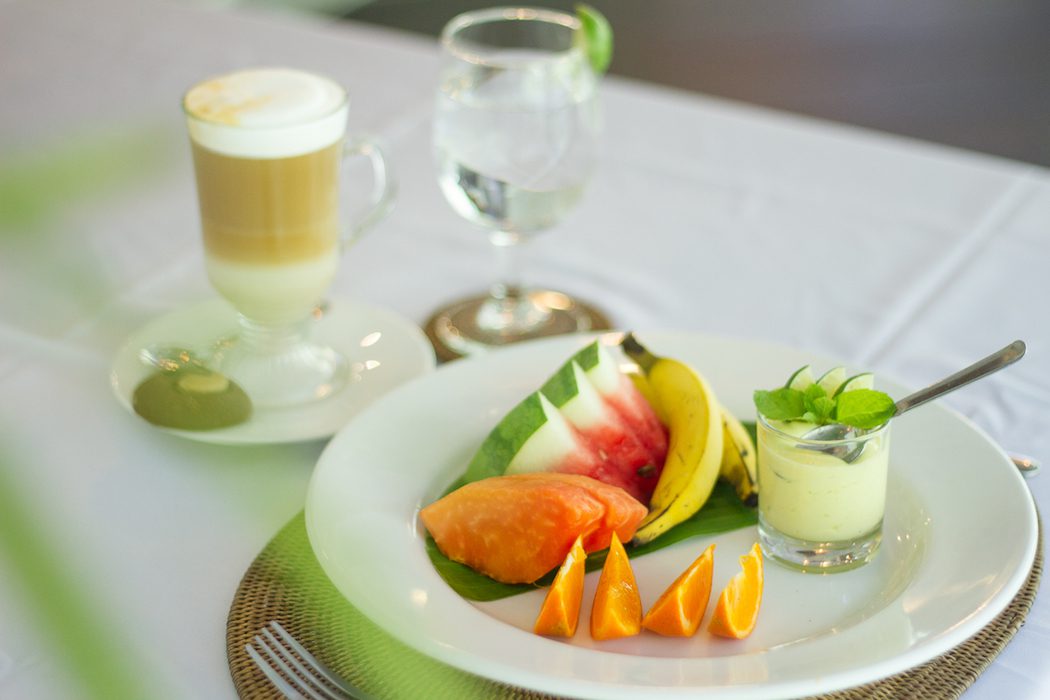
13.45 – 14.15: Video Editing Work Flow (Part 2) by Steve Fish. Organising your work flow to simplify editing and achieve the best results.
14.30: Dive 3 with Photo Pros Steve Fish, Hergen Spalink and onsite Lembeh Resort Photo Pro Sascha Janson and Marine Biologist Dimpy Jacobs
17.00 – 19.00: Office Hours – one on one time with the Pros.
19.00 – 20.30: A la Carte dinner with Roasted Pumpkin Soup, Selada Kacang Mete, Crispy Ground Beef Local Pancake, Almond Pork Tenderloin, Tondano Lobster in Coconut Curry Sauce, Nasi Goreng Ayam, Water Spinach and Feta Ravioli, Crème Caramel, Sorbet Of The Day, Fresh Fruit Platter.
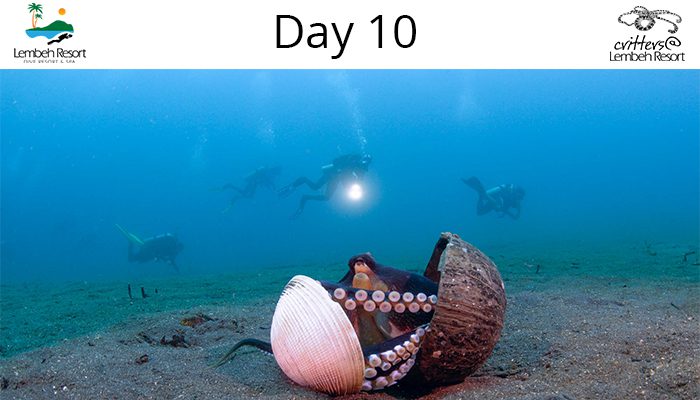
Day 10 Capturing Critters in Lembeh 2016 Wrap Up
It’s the last day of the 3 day “Advanced Extension” of our 5th annual Capturing Critters in Lembeh underwater photography and videography workshop and today’s program included a frogfish marine life presentation from our in house Marine Biologist Dimpy Jacobs in the morning and a video editing presentation in the afternoon from Steve Fish.
Participants made 3 dives in the Strait to put together and perfect everything they have been learning over the last 10 days with Photo Pros Hergen Spalink, Kerri Bingham, Steve Fish, in house Photo Pro Sascha Janson and in house Marine Biologist Dimpy Jacobs. Every day we have seen this year’s participants improve and develop new skills which have been reflected in the incredible portfolio of images which has been generated. Below is a selection of some of the best. We hope you enjoy them.

Participants images
Throughout the workshop the participants have attended 2 – 3 presentations a day and made 3 dives a day in the Lembeh Strait plus a day trip to Bangka Island for wide angle practice.
Presentations have been hosted by all five Pros and key topics have included tutoring in macro concepts, macro settings, lighting, composition, wide angle, macro, super macro, creative effects, Lightroom editing, video editing, macro accessories and lenses, backgrounds and negative space. They have worked hard, it’s been a lot of fun along the way and everyone will be taking home with them SD cards full of great shots as well as Steve Fish’s number 1 rule to Get Closer, followed by rule 2: Get Closer and rule 3: (you guessed it) Get Closer!
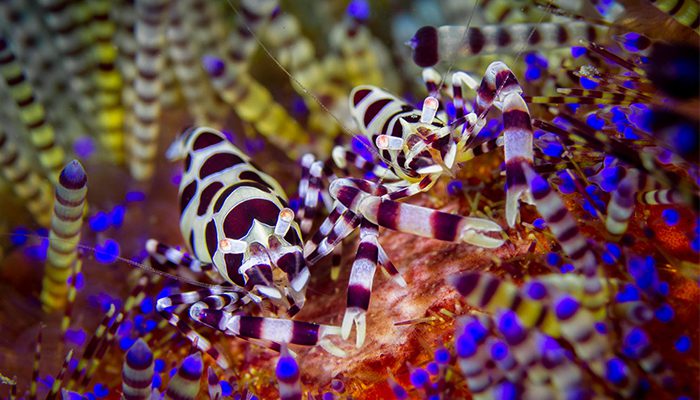
Coleman shrimp – periclimenes colemani
Photo by Sascha Janson
Some of the highlights from this year have included finding a pug-nose pipefish (a new discovery to science), Sascha’s narrow tail stingray in Bangka and Hergen’s pod of pilot whales at the end of the Strait, countless frogfish including hairy, painted, giant and clown on almost every dive, an innumerable number of nudibranch, blue ring octopus, coconut octopus, flamboyant cuttlefish, pygmy cuttlefish, tiger shrimps, hairy shrimps, Ambon scorpionfish, bargibanti, denise and pontohi pygmy seahorses, harlequin crabs, decorator crabs, upside down jellyfish crabs, ghost pipefish and the list goes on, this is Lembeh after all!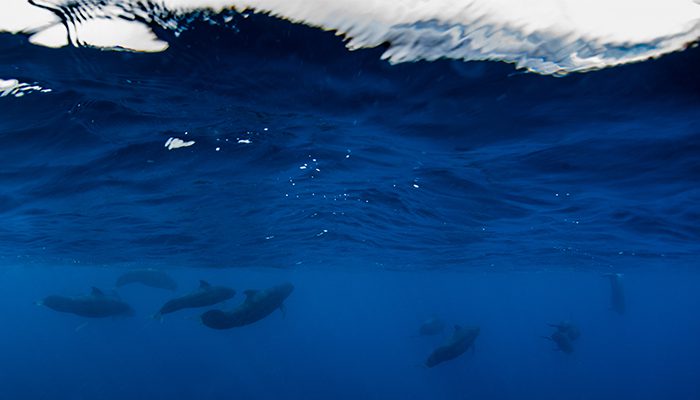
Pilot whale
Photo by Hergen Spalink
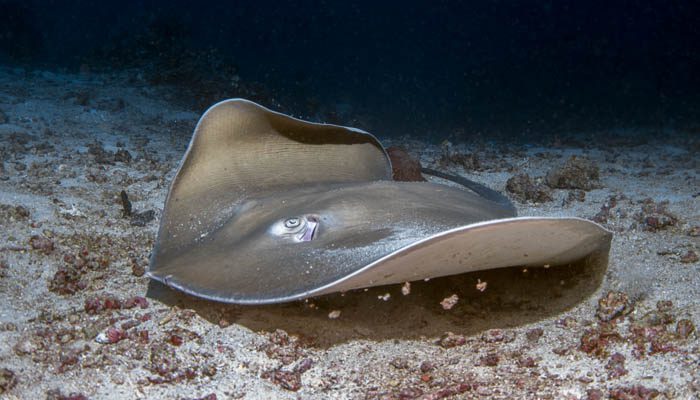
Stingray – Myliobatoidei
Photo by Sascha Janson
This evening is the Lembeh Resort Christmas Party so participants will finally be able to put the lens cap on, fold the strobe arms down and kick back for a night of fine dining and entertainment.
Thank you to all of the participants of this 5th annual Capturing Critters in Lembeh workshop and to the amazing team of Pros who have been on hand every step of the way to support, advise, share their wealth of knowledge and experience and inject some humour in moments of frustration!
Here’s what a couple of participants had to say about this years event:
Jessica Hardy (Sony RX7 100 MK IV): “At Lembeh Resort my needs were met before I even knew that I had them. It’s been an amazing experience”.
Dena Mintz (Nikon 800): “This is my second Capturing Critters in Lembeh workshop and my fourth stay at Lembeh Resort. The Pros have a way of explaining concepts which makes them easy to understand and to put into action. Getting to spend so much time with the Pros gives you an insight you can’t get from a book or by asking one off questions. I’ve been trying different techniques this year and that has been challenging but I wanted to break out of my photography comfort zone and move on to the next level, the workshop has definitely helped me to achieve that”.
Thank you again to everyone and we look forward to welcoming you back to the 6th annual Capturing Critters in Lembeh workshop from 6th – 13th December 2017 with optional advanced extension from 14th – 16th December 2017.
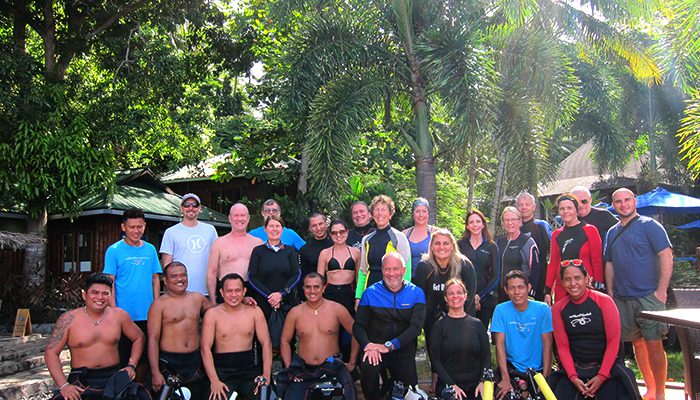
Sign up now for the 2017 Capturing Critters Photography Workshop with Martin Edge, Alex Tattersall and Ethan Daniels!
